Analysis of Principles of Marketing
VerifiedAdded on 2023/04/11
|20
|3809
|164
AI Summary
This document provides an analysis of the principles of marketing, focusing on the promotional mix, advertising, direct marketing, public relations, personal selling, and sales promotions used by Tesco. It also includes information about the company background and its strategies. The document uses the SWOT analysis framework and the segmentation, targeting, and positioning model to analyze Tesco's operations.
Contribute Materials
Your contribution can guide someone’s learning journey. Share your
documents today.
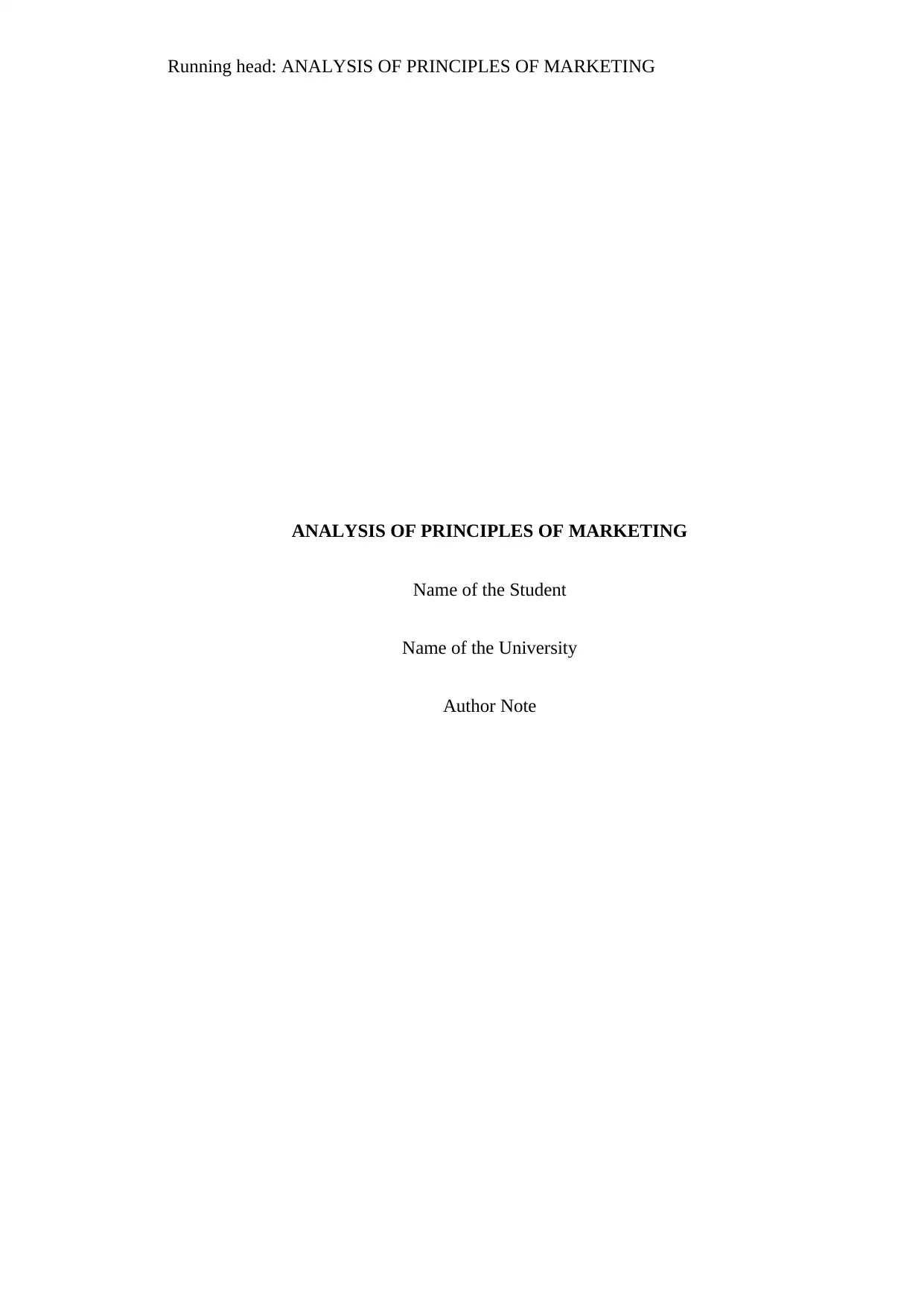
Running head: ANALYSIS OF PRINCIPLES OF MARKETING
ANALYSIS OF PRINCIPLES OF MARKETING
Name of the Student
Name of the University
Author Note
ANALYSIS OF PRINCIPLES OF MARKETING
Name of the Student
Name of the University
Author Note
Secure Best Marks with AI Grader
Need help grading? Try our AI Grader for instant feedback on your assignments.
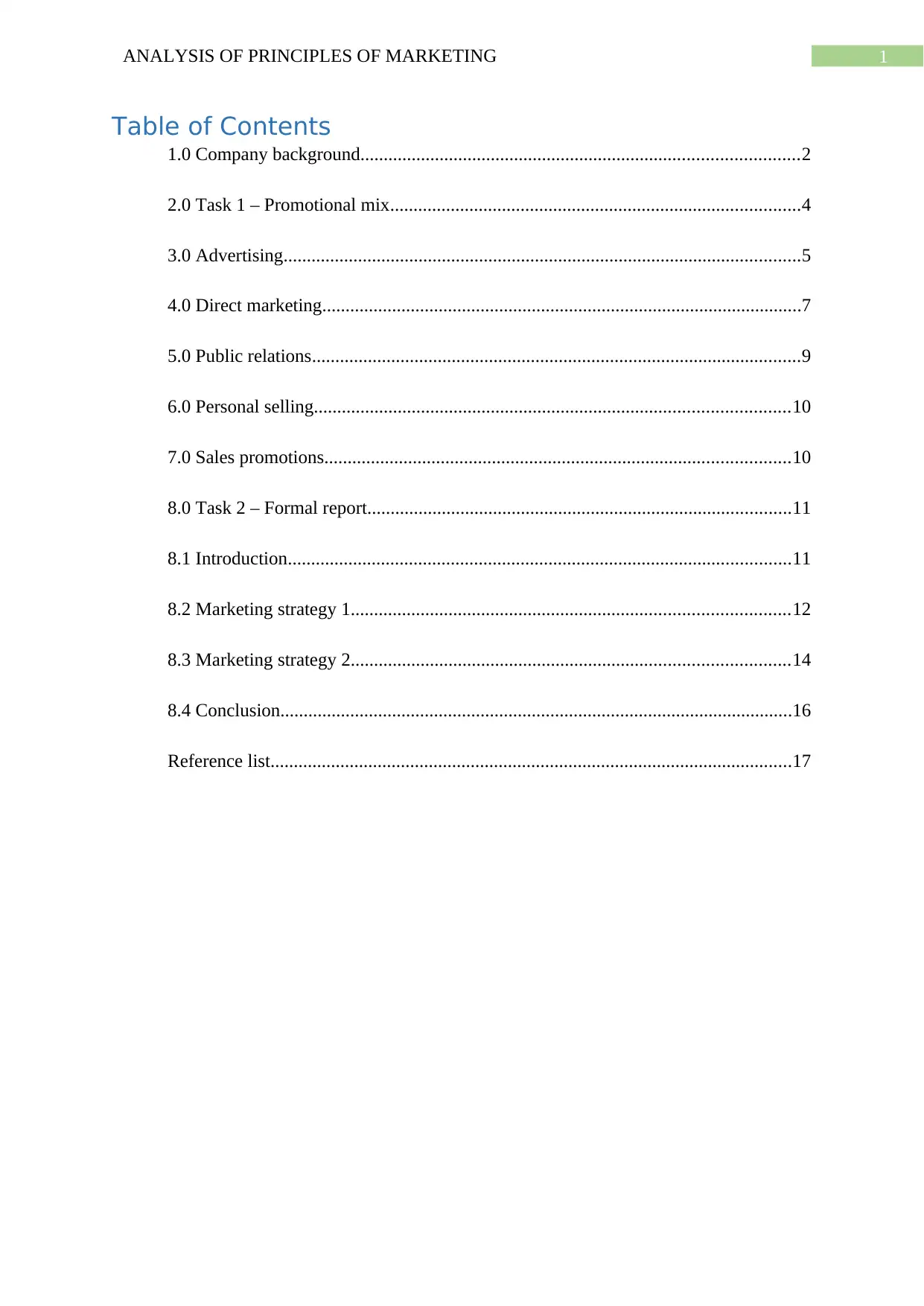
1ANALYSIS OF PRINCIPLES OF MARKETING
Table of Contents
1.0 Company background..............................................................................................2
2.0 Task 1 – Promotional mix........................................................................................4
3.0 Advertising...............................................................................................................5
4.0 Direct marketing.......................................................................................................7
5.0 Public relations.........................................................................................................9
6.0 Personal selling......................................................................................................10
7.0 Sales promotions....................................................................................................10
8.0 Task 2 – Formal report...........................................................................................11
8.1 Introduction............................................................................................................11
8.2 Marketing strategy 1..............................................................................................12
8.3 Marketing strategy 2..............................................................................................14
8.4 Conclusion..............................................................................................................16
Reference list................................................................................................................17
Table of Contents
1.0 Company background..............................................................................................2
2.0 Task 1 – Promotional mix........................................................................................4
3.0 Advertising...............................................................................................................5
4.0 Direct marketing.......................................................................................................7
5.0 Public relations.........................................................................................................9
6.0 Personal selling......................................................................................................10
7.0 Sales promotions....................................................................................................10
8.0 Task 2 – Formal report...........................................................................................11
8.1 Introduction............................................................................................................11
8.2 Marketing strategy 1..............................................................................................12
8.3 Marketing strategy 2..............................................................................................14
8.4 Conclusion..............................................................................................................16
Reference list................................................................................................................17

2ANALYSIS OF PRINCIPLES OF MARKETING
1.0 Company background
Tesco plc trading under the name of Tesco is a multinational grocery based
organization that has its origin in the United Kingdom. The organization mainly offers
different products like, general merchandise and groceries. The headquarter of the
organization is located in Welwyn Garden City, Hertfordshire, England, United Kingdom.
Tesco has gained the third largest position in the retail based sector of the UK in terms of
total revenues that have been gained in the industry. The organization has developed its stores
in seven countries all over the world. The operations of Tesco have been developed in
different countries across Asia and Europe (Tesco .com 2019).
The company has been a leader in the production of grocery based products and has
been able to gain an effective position in the retail industry as well. The mission statement of
Tesco is mainly based on the ways by which the company is able to become the business that
is valued by customers who are served by them. The employees of the organization are also
considered to be highly loyal and committed in nature (Tesco .com 2019). The mission
statement is of high importance for the effective operations of Tesco in the industry. The
company aims at operating in a profitable manner with the help of proper implementation of
the mission within strategies that are developed. Tesco has gained around 27.9% of the total
UK retail market and has developed the topmost position in the country in comparison to the
other countries like, Sainsbury’s, Asda, Morrisons and Aldi.
The different services that are offered by Tesco in the United Kingdom include,
insurance, personal loans, savings products, current accounts and mortgages. The demands
and needs of the consumers are taken into consideration by the organization in order to
provide them with the best levels of services. The products that are provided by Tesco
include, groceries, electrical products and many more. The organization aims at fulfilling the
1.0 Company background
Tesco plc trading under the name of Tesco is a multinational grocery based
organization that has its origin in the United Kingdom. The organization mainly offers
different products like, general merchandise and groceries. The headquarter of the
organization is located in Welwyn Garden City, Hertfordshire, England, United Kingdom.
Tesco has gained the third largest position in the retail based sector of the UK in terms of
total revenues that have been gained in the industry. The organization has developed its stores
in seven countries all over the world. The operations of Tesco have been developed in
different countries across Asia and Europe (Tesco .com 2019).
The company has been a leader in the production of grocery based products and has
been able to gain an effective position in the retail industry as well. The mission statement of
Tesco is mainly based on the ways by which the company is able to become the business that
is valued by customers who are served by them. The employees of the organization are also
considered to be highly loyal and committed in nature (Tesco .com 2019). The mission
statement is of high importance for the effective operations of Tesco in the industry. The
company aims at operating in a profitable manner with the help of proper implementation of
the mission within strategies that are developed. Tesco has gained around 27.9% of the total
UK retail market and has developed the topmost position in the country in comparison to the
other countries like, Sainsbury’s, Asda, Morrisons and Aldi.
The different services that are offered by Tesco in the United Kingdom include,
insurance, personal loans, savings products, current accounts and mortgages. The demands
and needs of the consumers are taken into consideration by the organization in order to
provide them with the best levels of services. The products that are provided by Tesco
include, groceries, electrical products and many more. The organization aims at fulfilling the
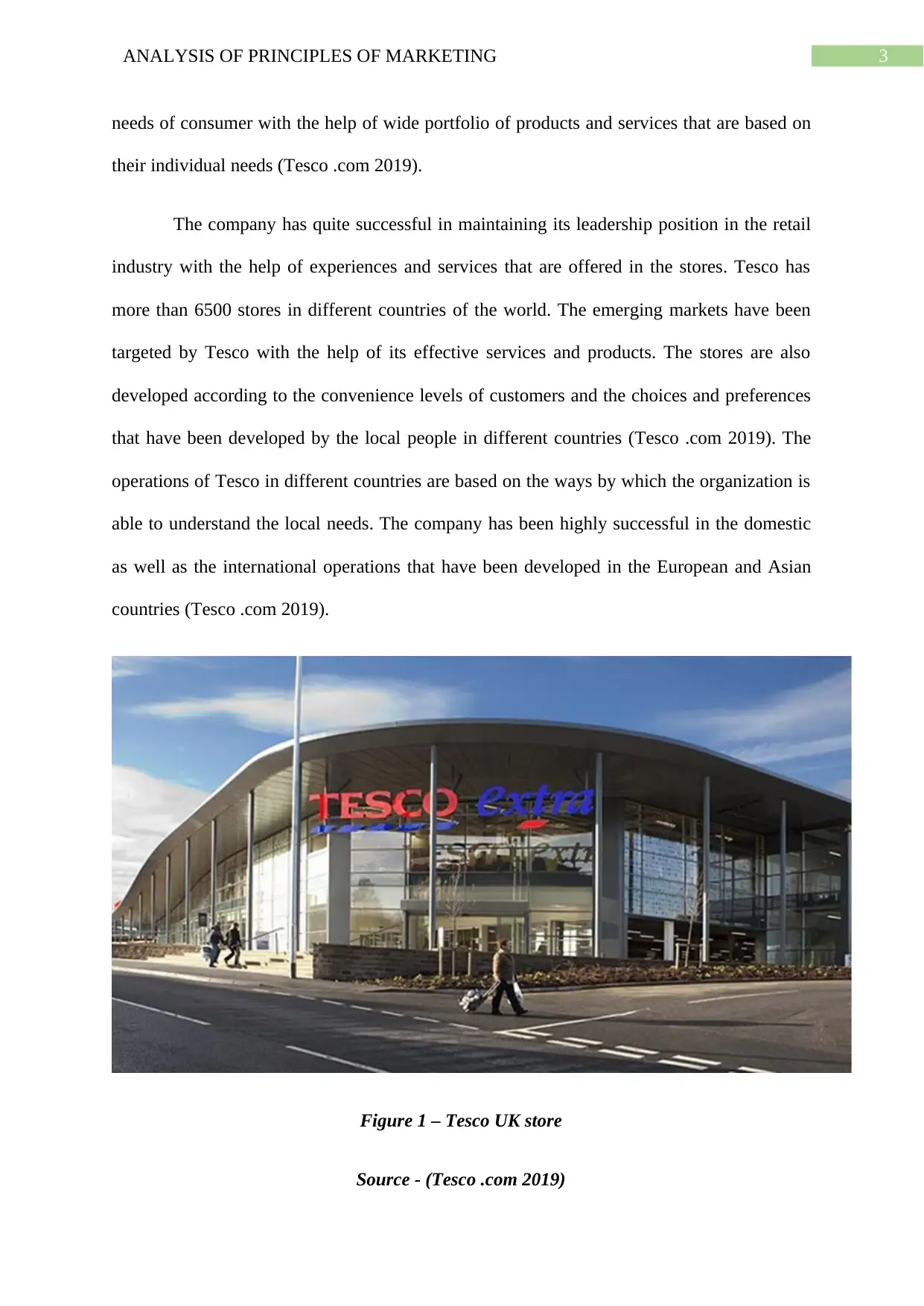
3ANALYSIS OF PRINCIPLES OF MARKETING
needs of consumer with the help of wide portfolio of products and services that are based on
their individual needs (Tesco .com 2019).
The company has quite successful in maintaining its leadership position in the retail
industry with the help of experiences and services that are offered in the stores. Tesco has
more than 6500 stores in different countries of the world. The emerging markets have been
targeted by Tesco with the help of its effective services and products. The stores are also
developed according to the convenience levels of customers and the choices and preferences
that have been developed by the local people in different countries (Tesco .com 2019). The
operations of Tesco in different countries are based on the ways by which the organization is
able to understand the local needs. The company has been highly successful in the domestic
as well as the international operations that have been developed in the European and Asian
countries (Tesco .com 2019).
Figure 1 – Tesco UK store
Source - (Tesco .com 2019)
needs of consumer with the help of wide portfolio of products and services that are based on
their individual needs (Tesco .com 2019).
The company has quite successful in maintaining its leadership position in the retail
industry with the help of experiences and services that are offered in the stores. Tesco has
more than 6500 stores in different countries of the world. The emerging markets have been
targeted by Tesco with the help of its effective services and products. The stores are also
developed according to the convenience levels of customers and the choices and preferences
that have been developed by the local people in different countries (Tesco .com 2019). The
operations of Tesco in different countries are based on the ways by which the organization is
able to understand the local needs. The company has been highly successful in the domestic
as well as the international operations that have been developed in the European and Asian
countries (Tesco .com 2019).
Figure 1 – Tesco UK store
Source - (Tesco .com 2019)
Secure Best Marks with AI Grader
Need help grading? Try our AI Grader for instant feedback on your assignments.
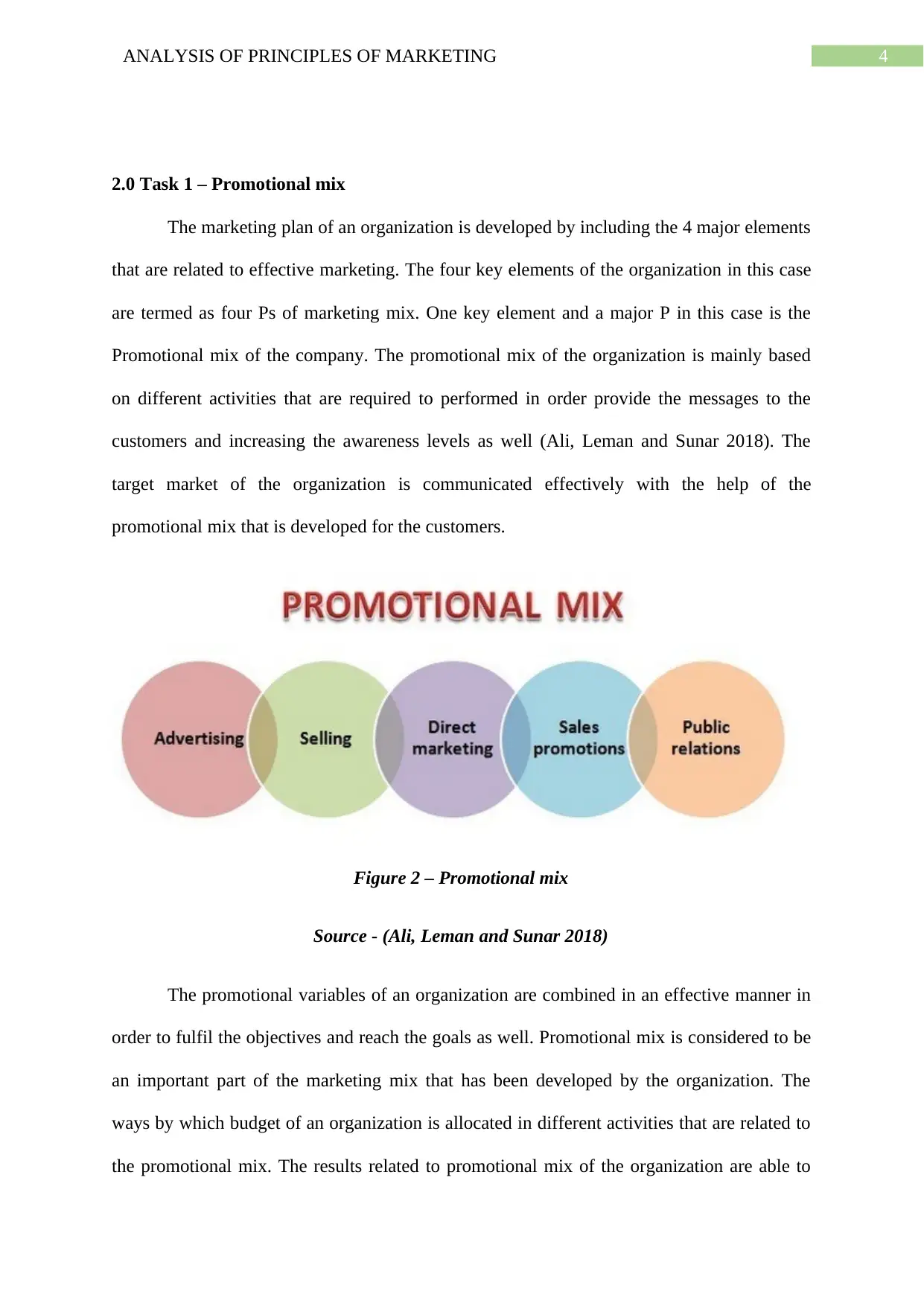
4ANALYSIS OF PRINCIPLES OF MARKETING
2.0 Task 1 – Promotional mix
The marketing plan of an organization is developed by including the 4 major elements
that are related to effective marketing. The four key elements of the organization in this case
are termed as four Ps of marketing mix. One key element and a major P in this case is the
Promotional mix of the company. The promotional mix of the organization is mainly based
on different activities that are required to performed in order provide the messages to the
customers and increasing the awareness levels as well (Ali, Leman and Sunar 2018). The
target market of the organization is communicated effectively with the help of the
promotional mix that is developed for the customers.
Figure 2 – Promotional mix
Source - (Ali, Leman and Sunar 2018)
The promotional variables of an organization are combined in an effective manner in
order to fulfil the objectives and reach the goals as well. Promotional mix is considered to be
an important part of the marketing mix that has been developed by the organization. The
ways by which budget of an organization is allocated in different activities that are related to
the promotional mix. The results related to promotional mix of the organization are able to
2.0 Task 1 – Promotional mix
The marketing plan of an organization is developed by including the 4 major elements
that are related to effective marketing. The four key elements of the organization in this case
are termed as four Ps of marketing mix. One key element and a major P in this case is the
Promotional mix of the company. The promotional mix of the organization is mainly based
on different activities that are required to performed in order provide the messages to the
customers and increasing the awareness levels as well (Ali, Leman and Sunar 2018). The
target market of the organization is communicated effectively with the help of the
promotional mix that is developed for the customers.
Figure 2 – Promotional mix
Source - (Ali, Leman and Sunar 2018)
The promotional variables of an organization are combined in an effective manner in
order to fulfil the objectives and reach the goals as well. Promotional mix is considered to be
an important part of the marketing mix that has been developed by the organization. The
ways by which budget of an organization is allocated in different activities that are related to
the promotional mix. The results related to promotional mix of the organization are able to
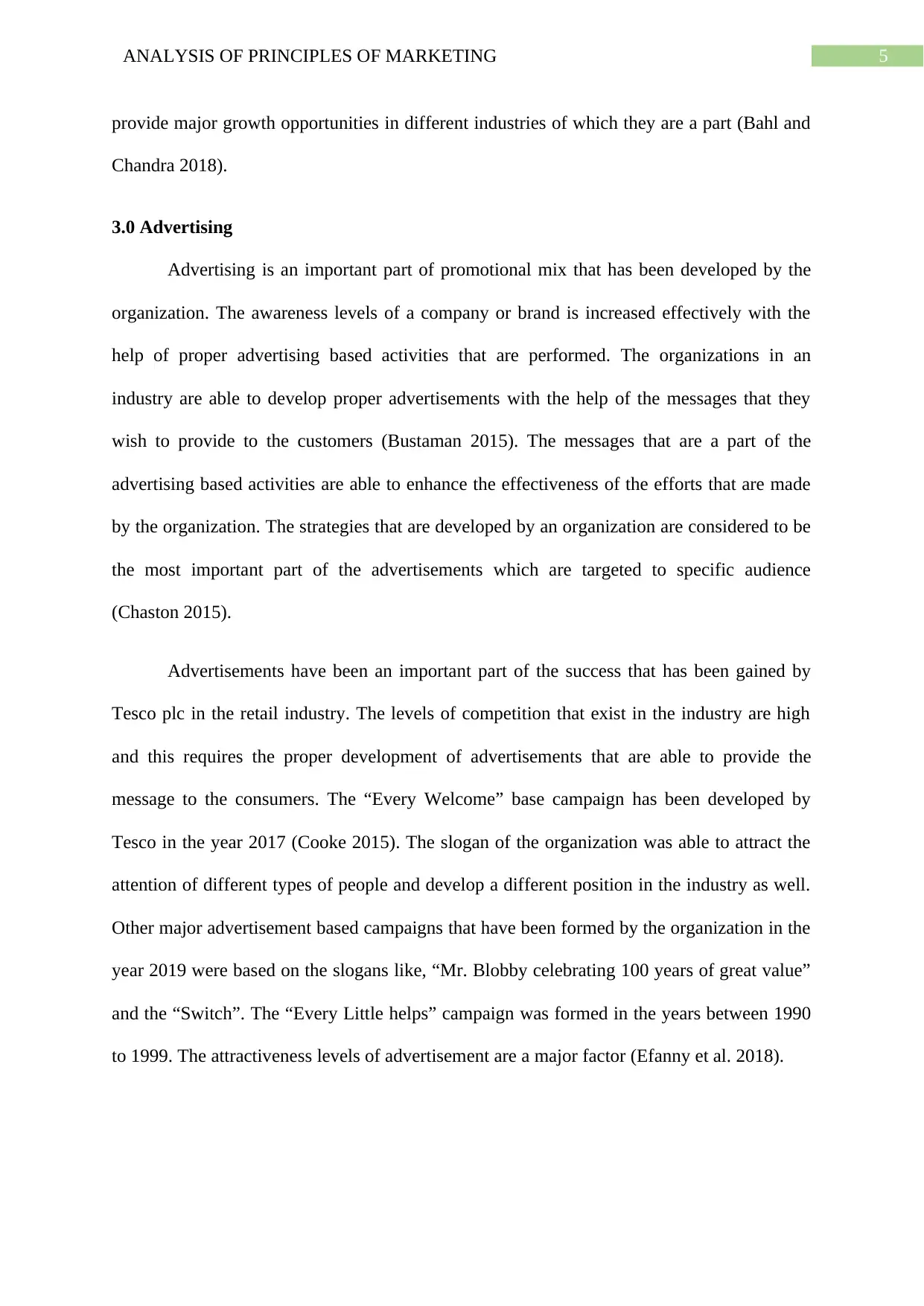
5ANALYSIS OF PRINCIPLES OF MARKETING
provide major growth opportunities in different industries of which they are a part (Bahl and
Chandra 2018).
3.0 Advertising
Advertising is an important part of promotional mix that has been developed by the
organization. The awareness levels of a company or brand is increased effectively with the
help of proper advertising based activities that are performed. The organizations in an
industry are able to develop proper advertisements with the help of the messages that they
wish to provide to the customers (Bustaman 2015). The messages that are a part of the
advertising based activities are able to enhance the effectiveness of the efforts that are made
by the organization. The strategies that are developed by an organization are considered to be
the most important part of the advertisements which are targeted to specific audience
(Chaston 2015).
Advertisements have been an important part of the success that has been gained by
Tesco plc in the retail industry. The levels of competition that exist in the industry are high
and this requires the proper development of advertisements that are able to provide the
message to the consumers. The “Every Welcome” base campaign has been developed by
Tesco in the year 2017 (Cooke 2015). The slogan of the organization was able to attract the
attention of different types of people and develop a different position in the industry as well.
Other major advertisement based campaigns that have been formed by the organization in the
year 2019 were based on the slogans like, “Mr. Blobby celebrating 100 years of great value”
and the “Switch”. The “Every Little helps” campaign was formed in the years between 1990
to 1999. The attractiveness levels of advertisement are a major factor (Efanny et al. 2018).
provide major growth opportunities in different industries of which they are a part (Bahl and
Chandra 2018).
3.0 Advertising
Advertising is an important part of promotional mix that has been developed by the
organization. The awareness levels of a company or brand is increased effectively with the
help of proper advertising based activities that are performed. The organizations in an
industry are able to develop proper advertisements with the help of the messages that they
wish to provide to the customers (Bustaman 2015). The messages that are a part of the
advertising based activities are able to enhance the effectiveness of the efforts that are made
by the organization. The strategies that are developed by an organization are considered to be
the most important part of the advertisements which are targeted to specific audience
(Chaston 2015).
Advertisements have been an important part of the success that has been gained by
Tesco plc in the retail industry. The levels of competition that exist in the industry are high
and this requires the proper development of advertisements that are able to provide the
message to the consumers. The “Every Welcome” base campaign has been developed by
Tesco in the year 2017 (Cooke 2015). The slogan of the organization was able to attract the
attention of different types of people and develop a different position in the industry as well.
Other major advertisement based campaigns that have been formed by the organization in the
year 2019 were based on the slogans like, “Mr. Blobby celebrating 100 years of great value”
and the “Switch”. The “Every Little helps” campaign was formed in the years between 1990
to 1999. The attractiveness levels of advertisement are a major factor (Efanny et al. 2018).
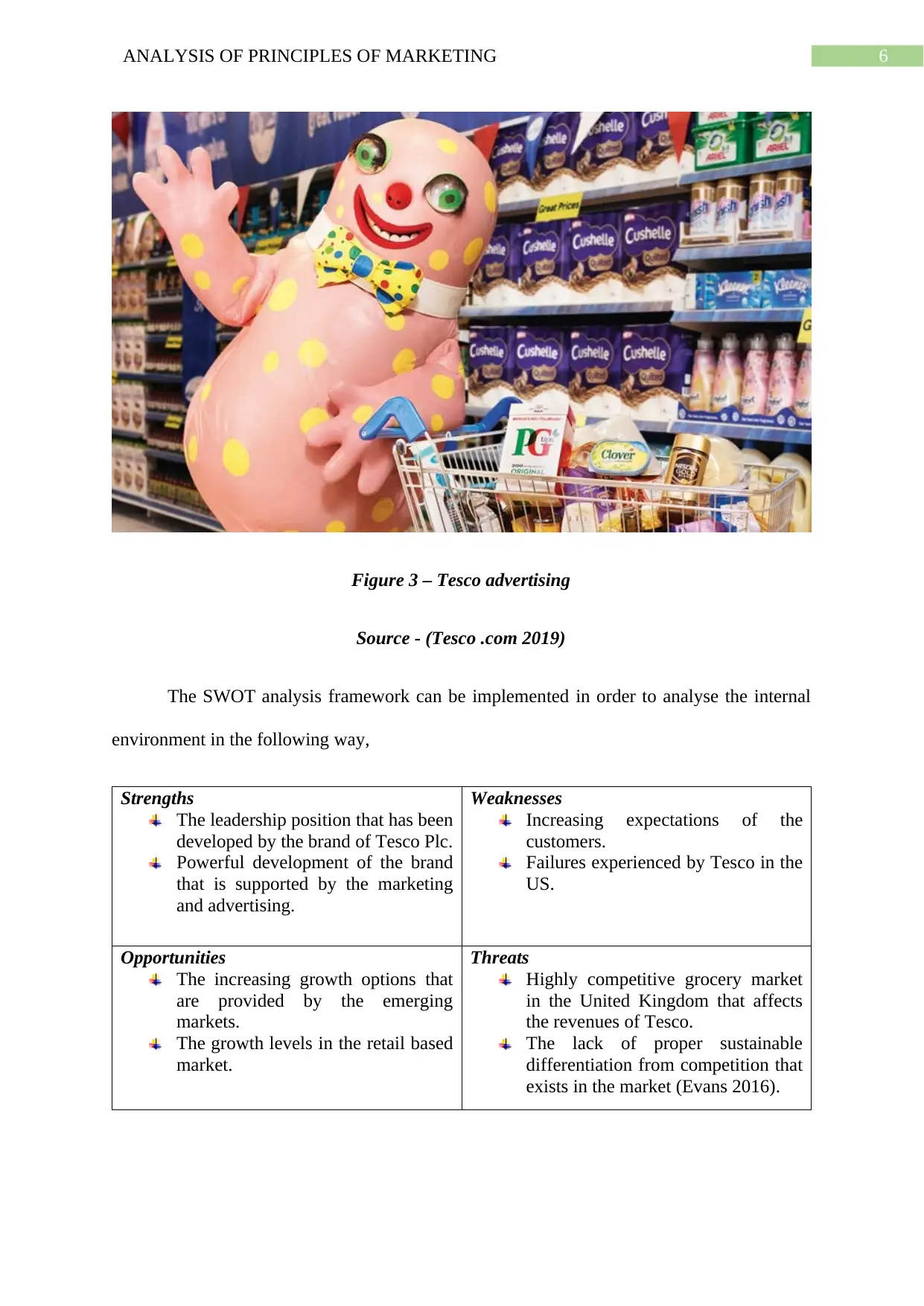
6ANALYSIS OF PRINCIPLES OF MARKETING
Figure 3 – Tesco advertising
Source - (Tesco .com 2019)
The SWOT analysis framework can be implemented in order to analyse the internal
environment in the following way,
Strengths
The leadership position that has been
developed by the brand of Tesco Plc.
Powerful development of the brand
that is supported by the marketing
and advertising.
Weaknesses
Increasing expectations of the
customers.
Failures experienced by Tesco in the
US.
Opportunities
The increasing growth options that
are provided by the emerging
markets.
The growth levels in the retail based
market.
Threats
Highly competitive grocery market
in the United Kingdom that affects
the revenues of Tesco.
The lack of proper sustainable
differentiation from competition that
exists in the market (Evans 2016).
Figure 3 – Tesco advertising
Source - (Tesco .com 2019)
The SWOT analysis framework can be implemented in order to analyse the internal
environment in the following way,
Strengths
The leadership position that has been
developed by the brand of Tesco Plc.
Powerful development of the brand
that is supported by the marketing
and advertising.
Weaknesses
Increasing expectations of the
customers.
Failures experienced by Tesco in the
US.
Opportunities
The increasing growth options that
are provided by the emerging
markets.
The growth levels in the retail based
market.
Threats
Highly competitive grocery market
in the United Kingdom that affects
the revenues of Tesco.
The lack of proper sustainable
differentiation from competition that
exists in the market (Evans 2016).
Paraphrase This Document
Need a fresh take? Get an instant paraphrase of this document with our AI Paraphraser
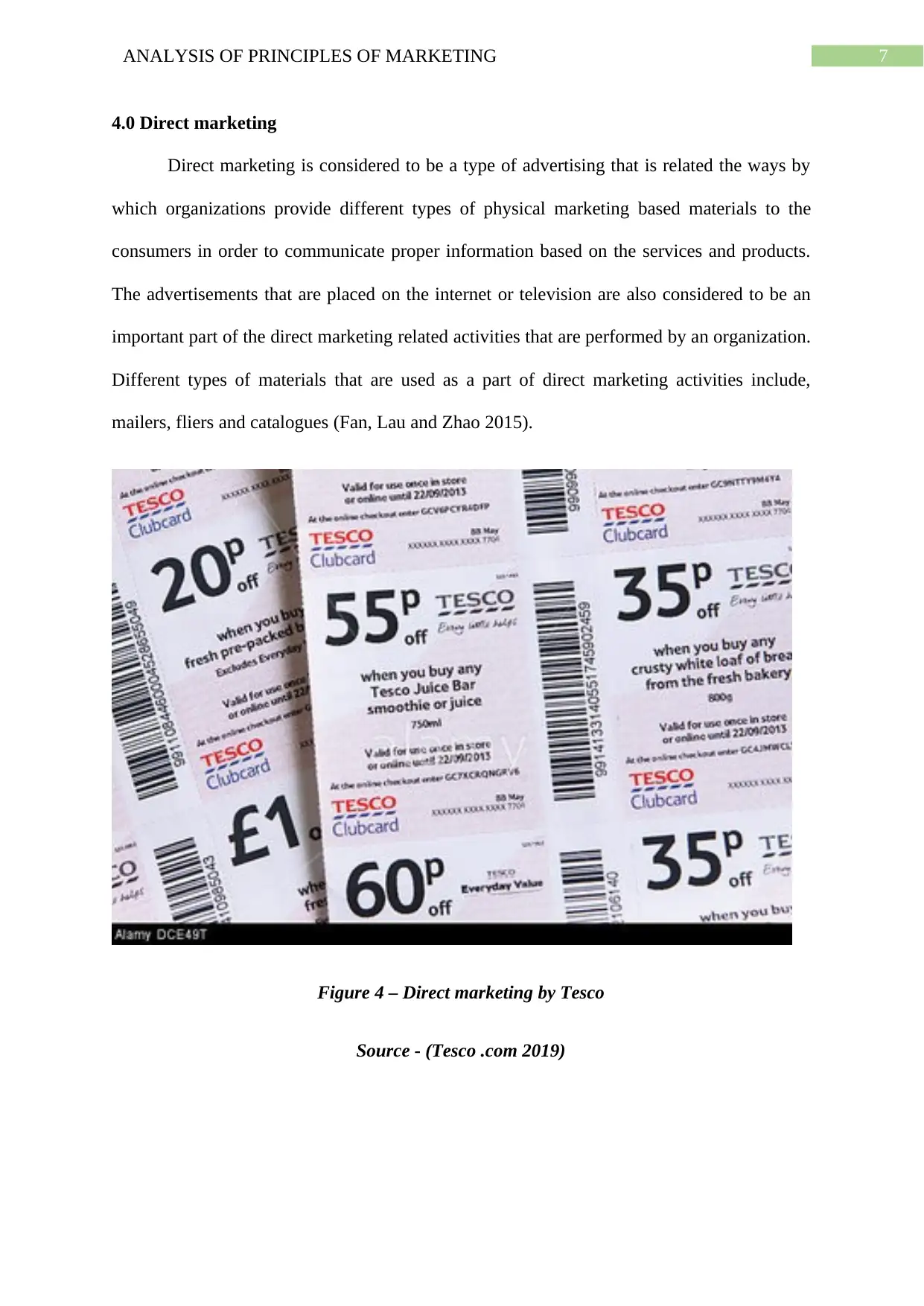
7ANALYSIS OF PRINCIPLES OF MARKETING
4.0 Direct marketing
Direct marketing is considered to be a type of advertising that is related the ways by
which organizations provide different types of physical marketing based materials to the
consumers in order to communicate proper information based on the services and products.
The advertisements that are placed on the internet or television are also considered to be an
important part of the direct marketing related activities that are performed by an organization.
Different types of materials that are used as a part of direct marketing activities include,
mailers, fliers and catalogues (Fan, Lau and Zhao 2015).
Figure 4 – Direct marketing by Tesco
Source - (Tesco .com 2019)
4.0 Direct marketing
Direct marketing is considered to be a type of advertising that is related the ways by
which organizations provide different types of physical marketing based materials to the
consumers in order to communicate proper information based on the services and products.
The advertisements that are placed on the internet or television are also considered to be an
important part of the direct marketing related activities that are performed by an organization.
Different types of materials that are used as a part of direct marketing activities include,
mailers, fliers and catalogues (Fan, Lau and Zhao 2015).
Figure 4 – Direct marketing by Tesco
Source - (Tesco .com 2019)
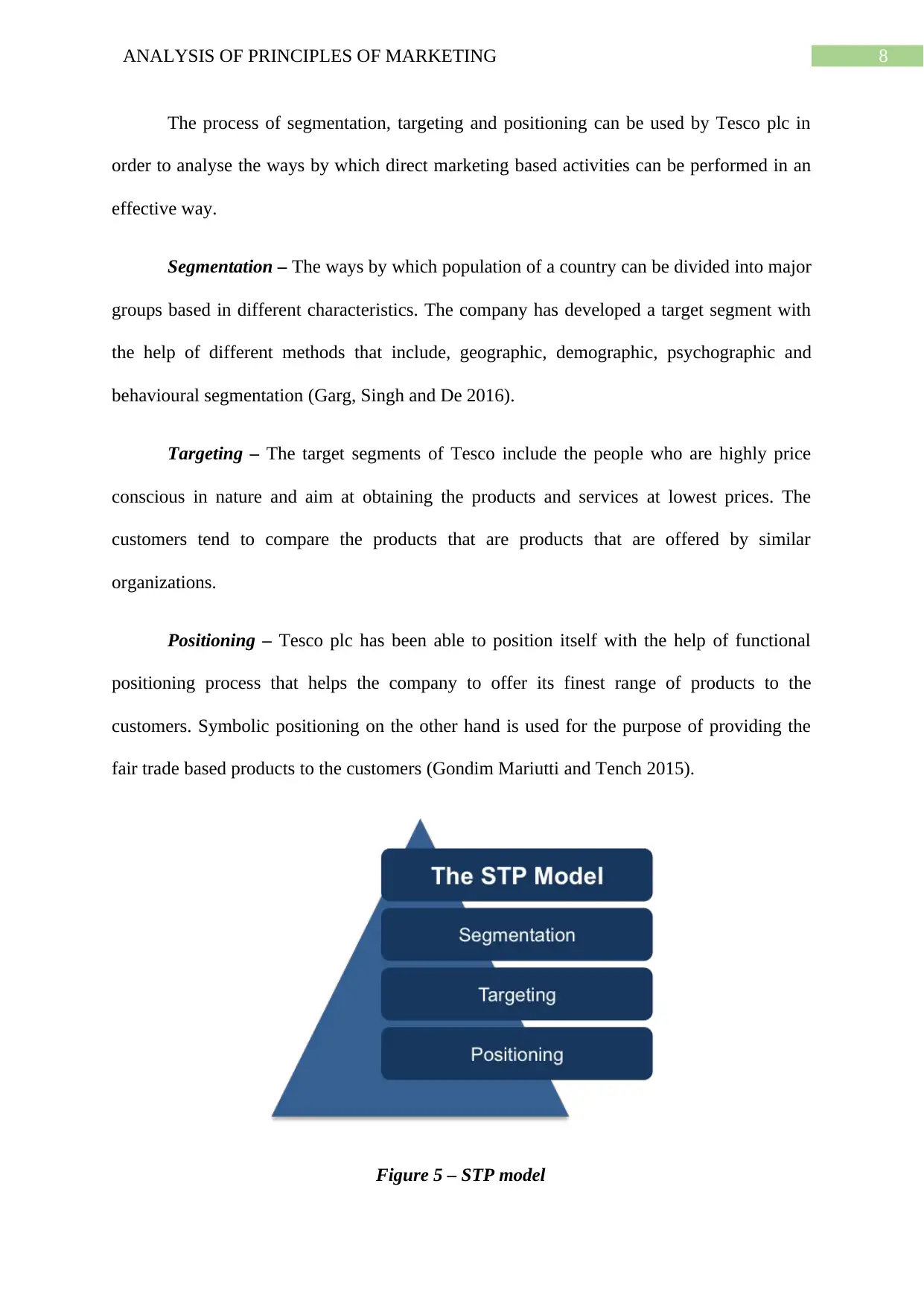
8ANALYSIS OF PRINCIPLES OF MARKETING
The process of segmentation, targeting and positioning can be used by Tesco plc in
order to analyse the ways by which direct marketing based activities can be performed in an
effective way.
Segmentation – The ways by which population of a country can be divided into major
groups based in different characteristics. The company has developed a target segment with
the help of different methods that include, geographic, demographic, psychographic and
behavioural segmentation (Garg, Singh and De 2016).
Targeting – The target segments of Tesco include the people who are highly price
conscious in nature and aim at obtaining the products and services at lowest prices. The
customers tend to compare the products that are products that are offered by similar
organizations.
Positioning – Tesco plc has been able to position itself with the help of functional
positioning process that helps the company to offer its finest range of products to the
customers. Symbolic positioning on the other hand is used for the purpose of providing the
fair trade based products to the customers (Gondim Mariutti and Tench 2015).
Figure 5 – STP model
The process of segmentation, targeting and positioning can be used by Tesco plc in
order to analyse the ways by which direct marketing based activities can be performed in an
effective way.
Segmentation – The ways by which population of a country can be divided into major
groups based in different characteristics. The company has developed a target segment with
the help of different methods that include, geographic, demographic, psychographic and
behavioural segmentation (Garg, Singh and De 2016).
Targeting – The target segments of Tesco include the people who are highly price
conscious in nature and aim at obtaining the products and services at lowest prices. The
customers tend to compare the products that are products that are offered by similar
organizations.
Positioning – Tesco plc has been able to position itself with the help of functional
positioning process that helps the company to offer its finest range of products to the
customers. Symbolic positioning on the other hand is used for the purpose of providing the
fair trade based products to the customers (Gondim Mariutti and Tench 2015).
Figure 5 – STP model
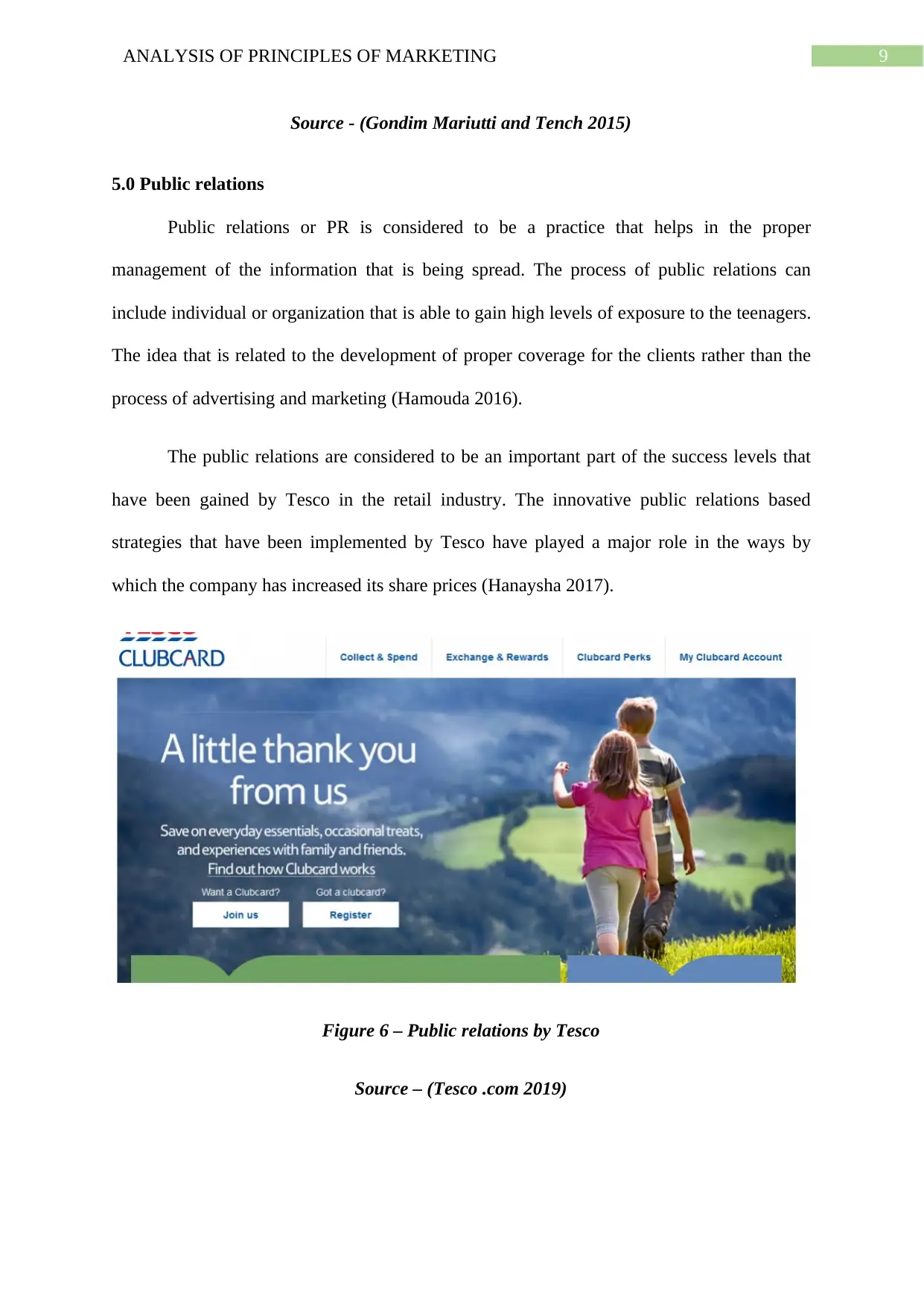
9ANALYSIS OF PRINCIPLES OF MARKETING
Source - (Gondim Mariutti and Tench 2015)
5.0 Public relations
Public relations or PR is considered to be a practice that helps in the proper
management of the information that is being spread. The process of public relations can
include individual or organization that is able to gain high levels of exposure to the teenagers.
The idea that is related to the development of proper coverage for the clients rather than the
process of advertising and marketing (Hamouda 2016).
The public relations are considered to be an important part of the success levels that
have been gained by Tesco in the retail industry. The innovative public relations based
strategies that have been implemented by Tesco have played a major role in the ways by
which the company has increased its share prices (Hanaysha 2017).
Figure 6 – Public relations by Tesco
Source – (Tesco .com 2019)
Source - (Gondim Mariutti and Tench 2015)
5.0 Public relations
Public relations or PR is considered to be a practice that helps in the proper
management of the information that is being spread. The process of public relations can
include individual or organization that is able to gain high levels of exposure to the teenagers.
The idea that is related to the development of proper coverage for the clients rather than the
process of advertising and marketing (Hamouda 2016).
The public relations are considered to be an important part of the success levels that
have been gained by Tesco in the retail industry. The innovative public relations based
strategies that have been implemented by Tesco have played a major role in the ways by
which the company has increased its share prices (Hanaysha 2017).
Figure 6 – Public relations by Tesco
Source – (Tesco .com 2019)
Secure Best Marks with AI Grader
Need help grading? Try our AI Grader for instant feedback on your assignments.
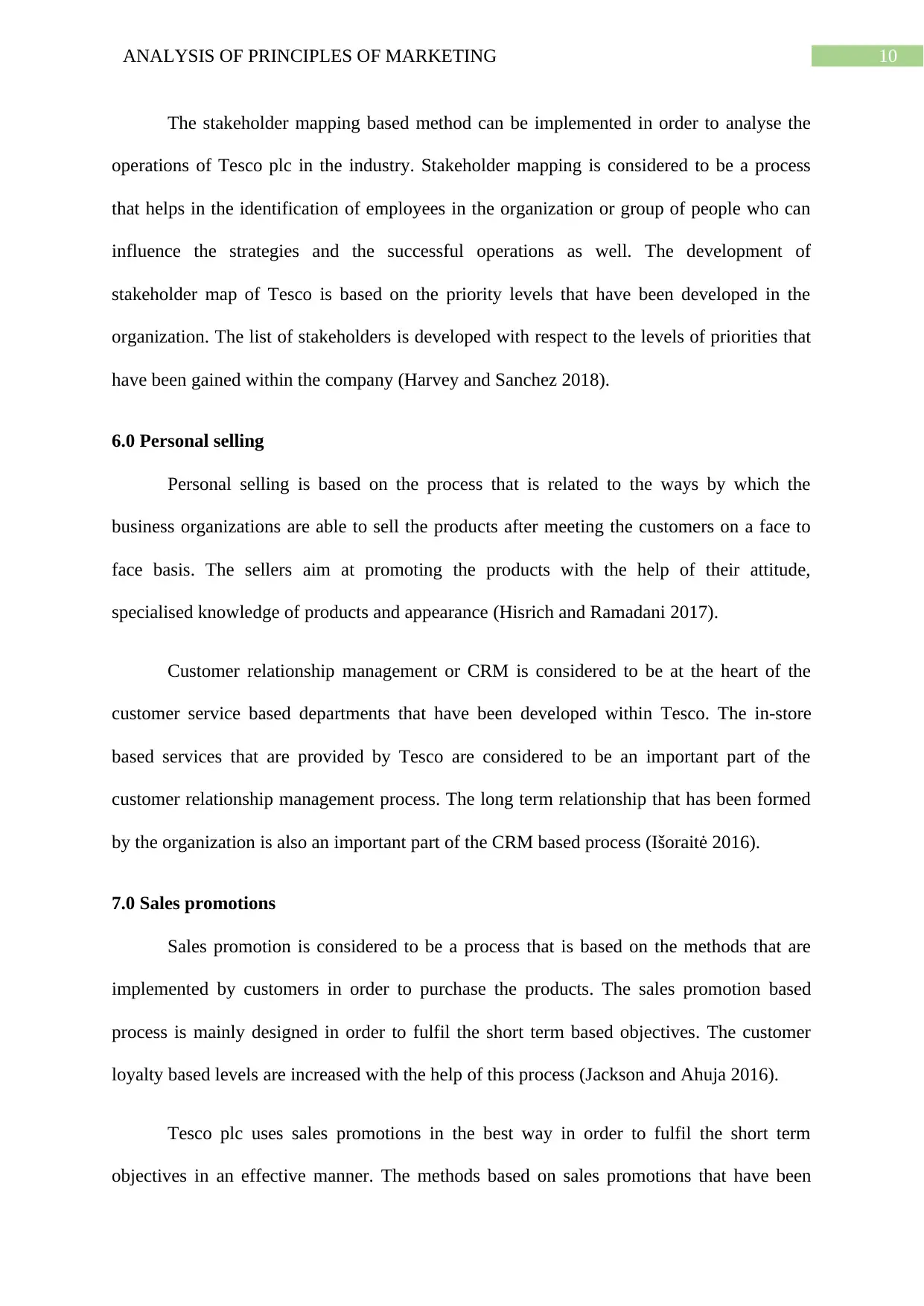
10ANALYSIS OF PRINCIPLES OF MARKETING
The stakeholder mapping based method can be implemented in order to analyse the
operations of Tesco plc in the industry. Stakeholder mapping is considered to be a process
that helps in the identification of employees in the organization or group of people who can
influence the strategies and the successful operations as well. The development of
stakeholder map of Tesco is based on the priority levels that have been developed in the
organization. The list of stakeholders is developed with respect to the levels of priorities that
have been gained within the company (Harvey and Sanchez 2018).
6.0 Personal selling
Personal selling is based on the process that is related to the ways by which the
business organizations are able to sell the products after meeting the customers on a face to
face basis. The sellers aim at promoting the products with the help of their attitude,
specialised knowledge of products and appearance (Hisrich and Ramadani 2017).
Customer relationship management or CRM is considered to be at the heart of the
customer service based departments that have been developed within Tesco. The in-store
based services that are provided by Tesco are considered to be an important part of the
customer relationship management process. The long term relationship that has been formed
by the organization is also an important part of the CRM based process (Išoraitė 2016).
7.0 Sales promotions
Sales promotion is considered to be a process that is based on the methods that are
implemented by customers in order to purchase the products. The sales promotion based
process is mainly designed in order to fulfil the short term based objectives. The customer
loyalty based levels are increased with the help of this process (Jackson and Ahuja 2016).
Tesco plc uses sales promotions in the best way in order to fulfil the short term
objectives in an effective manner. The methods based on sales promotions that have been
The stakeholder mapping based method can be implemented in order to analyse the
operations of Tesco plc in the industry. Stakeholder mapping is considered to be a process
that helps in the identification of employees in the organization or group of people who can
influence the strategies and the successful operations as well. The development of
stakeholder map of Tesco is based on the priority levels that have been developed in the
organization. The list of stakeholders is developed with respect to the levels of priorities that
have been gained within the company (Harvey and Sanchez 2018).
6.0 Personal selling
Personal selling is based on the process that is related to the ways by which the
business organizations are able to sell the products after meeting the customers on a face to
face basis. The sellers aim at promoting the products with the help of their attitude,
specialised knowledge of products and appearance (Hisrich and Ramadani 2017).
Customer relationship management or CRM is considered to be at the heart of the
customer service based departments that have been developed within Tesco. The in-store
based services that are provided by Tesco are considered to be an important part of the
customer relationship management process. The long term relationship that has been formed
by the organization is also an important part of the CRM based process (Išoraitė 2016).
7.0 Sales promotions
Sales promotion is considered to be a process that is based on the methods that are
implemented by customers in order to purchase the products. The sales promotion based
process is mainly designed in order to fulfil the short term based objectives. The customer
loyalty based levels are increased with the help of this process (Jackson and Ahuja 2016).
Tesco plc uses sales promotions in the best way in order to fulfil the short term
objectives in an effective manner. The methods based on sales promotions that have been
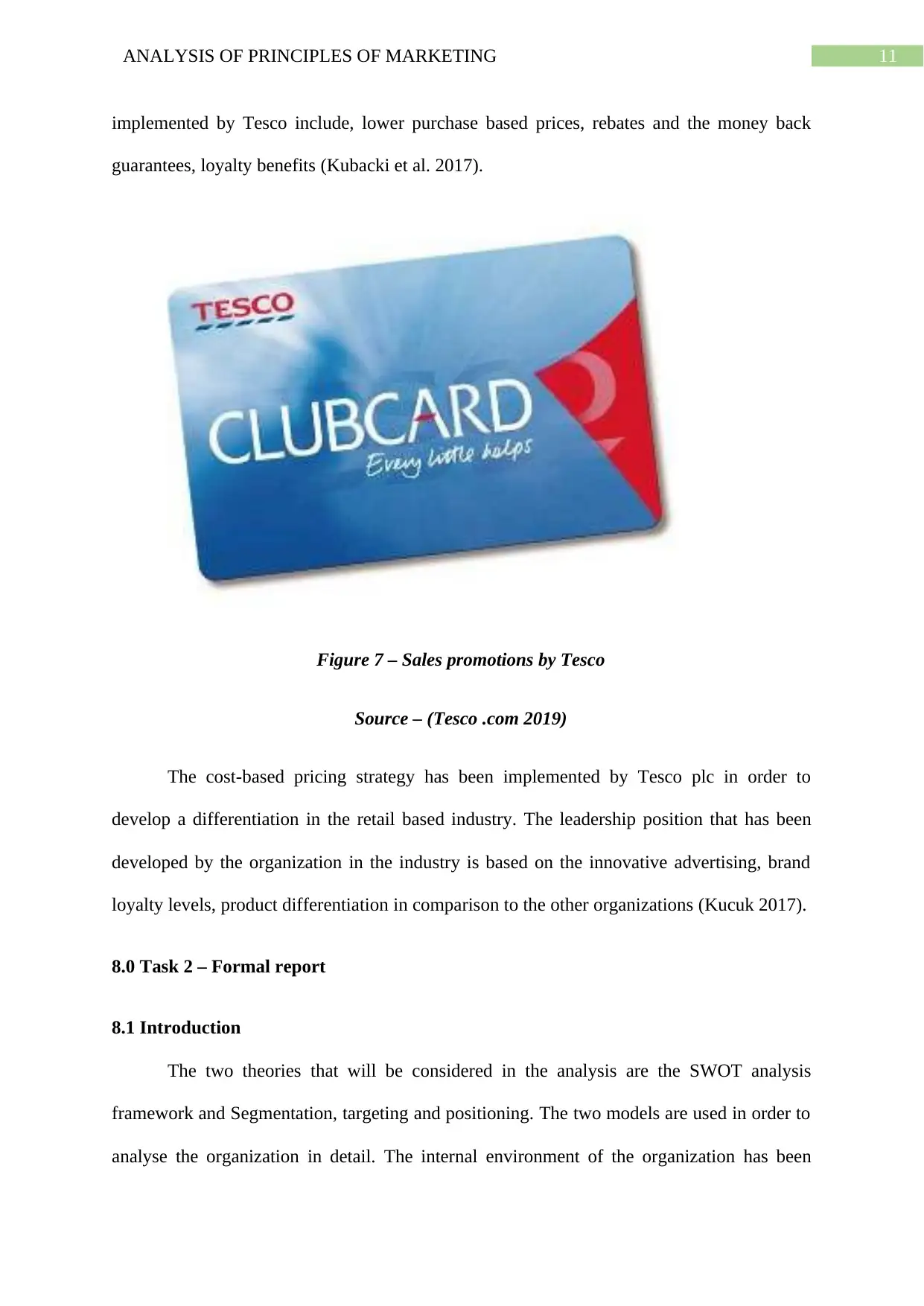
11ANALYSIS OF PRINCIPLES OF MARKETING
implemented by Tesco include, lower purchase based prices, rebates and the money back
guarantees, loyalty benefits (Kubacki et al. 2017).
Figure 7 – Sales promotions by Tesco
Source – (Tesco .com 2019)
The cost-based pricing strategy has been implemented by Tesco plc in order to
develop a differentiation in the retail based industry. The leadership position that has been
developed by the organization in the industry is based on the innovative advertising, brand
loyalty levels, product differentiation in comparison to the other organizations (Kucuk 2017).
8.0 Task 2 – Formal report
8.1 Introduction
The two theories that will be considered in the analysis are the SWOT analysis
framework and Segmentation, targeting and positioning. The two models are used in order to
analyse the organization in detail. The internal environment of the organization has been
implemented by Tesco include, lower purchase based prices, rebates and the money back
guarantees, loyalty benefits (Kubacki et al. 2017).
Figure 7 – Sales promotions by Tesco
Source – (Tesco .com 2019)
The cost-based pricing strategy has been implemented by Tesco plc in order to
develop a differentiation in the retail based industry. The leadership position that has been
developed by the organization in the industry is based on the innovative advertising, brand
loyalty levels, product differentiation in comparison to the other organizations (Kucuk 2017).
8.0 Task 2 – Formal report
8.1 Introduction
The two theories that will be considered in the analysis are the SWOT analysis
framework and Segmentation, targeting and positioning. The two models are used in order to
analyse the organization in detail. The internal environment of the organization has been
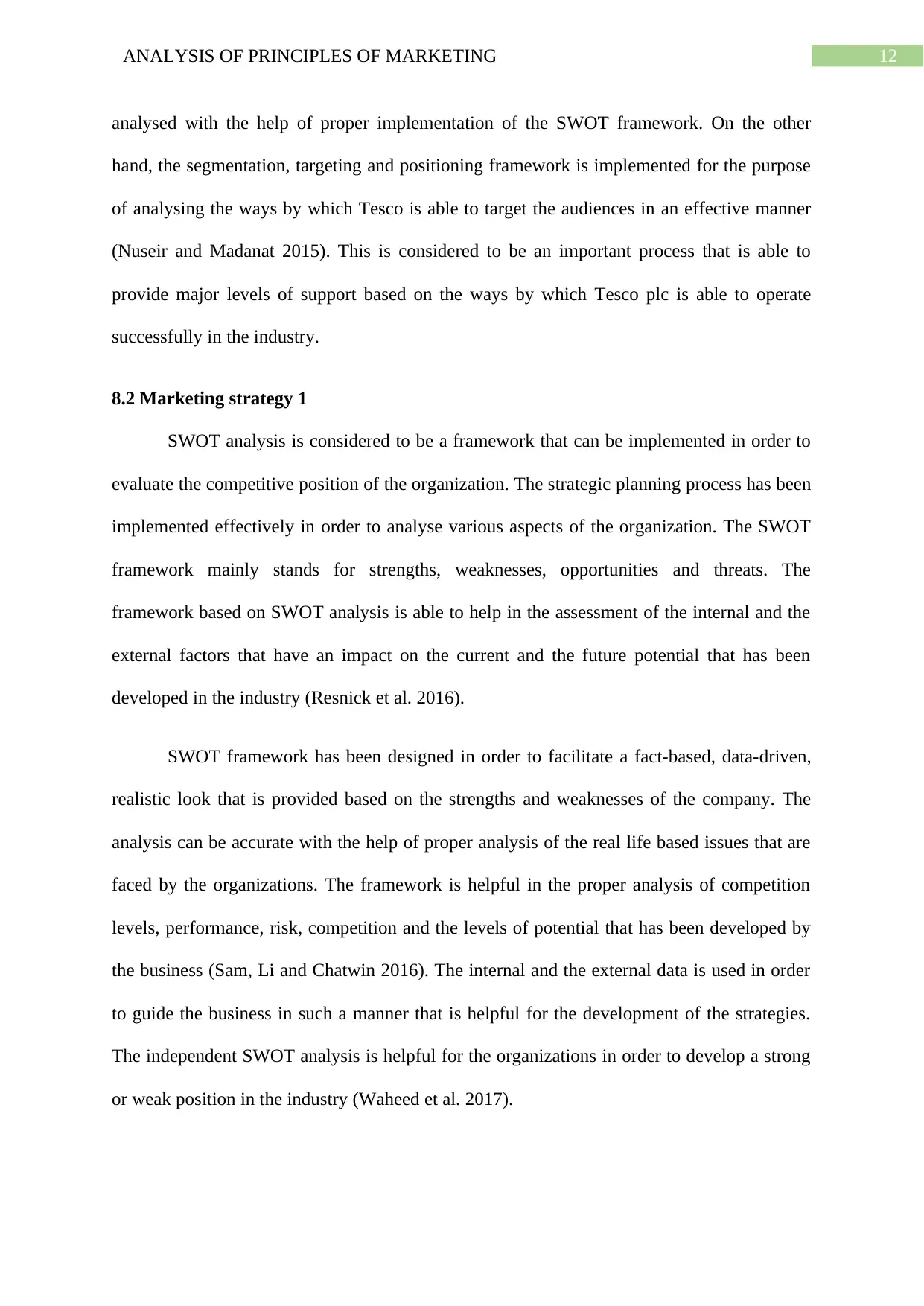
12ANALYSIS OF PRINCIPLES OF MARKETING
analysed with the help of proper implementation of the SWOT framework. On the other
hand, the segmentation, targeting and positioning framework is implemented for the purpose
of analysing the ways by which Tesco is able to target the audiences in an effective manner
(Nuseir and Madanat 2015). This is considered to be an important process that is able to
provide major levels of support based on the ways by which Tesco plc is able to operate
successfully in the industry.
8.2 Marketing strategy 1
SWOT analysis is considered to be a framework that can be implemented in order to
evaluate the competitive position of the organization. The strategic planning process has been
implemented effectively in order to analyse various aspects of the organization. The SWOT
framework mainly stands for strengths, weaknesses, opportunities and threats. The
framework based on SWOT analysis is able to help in the assessment of the internal and the
external factors that have an impact on the current and the future potential that has been
developed in the industry (Resnick et al. 2016).
SWOT framework has been designed in order to facilitate a fact-based, data-driven,
realistic look that is provided based on the strengths and weaknesses of the company. The
analysis can be accurate with the help of proper analysis of the real life based issues that are
faced by the organizations. The framework is helpful in the proper analysis of competition
levels, performance, risk, competition and the levels of potential that has been developed by
the business (Sam, Li and Chatwin 2016). The internal and the external data is used in order
to guide the business in such a manner that is helpful for the development of the strategies.
The independent SWOT analysis is helpful for the organizations in order to develop a strong
or weak position in the industry (Waheed et al. 2017).
analysed with the help of proper implementation of the SWOT framework. On the other
hand, the segmentation, targeting and positioning framework is implemented for the purpose
of analysing the ways by which Tesco is able to target the audiences in an effective manner
(Nuseir and Madanat 2015). This is considered to be an important process that is able to
provide major levels of support based on the ways by which Tesco plc is able to operate
successfully in the industry.
8.2 Marketing strategy 1
SWOT analysis is considered to be a framework that can be implemented in order to
evaluate the competitive position of the organization. The strategic planning process has been
implemented effectively in order to analyse various aspects of the organization. The SWOT
framework mainly stands for strengths, weaknesses, opportunities and threats. The
framework based on SWOT analysis is able to help in the assessment of the internal and the
external factors that have an impact on the current and the future potential that has been
developed in the industry (Resnick et al. 2016).
SWOT framework has been designed in order to facilitate a fact-based, data-driven,
realistic look that is provided based on the strengths and weaknesses of the company. The
analysis can be accurate with the help of proper analysis of the real life based issues that are
faced by the organizations. The framework is helpful in the proper analysis of competition
levels, performance, risk, competition and the levels of potential that has been developed by
the business (Sam, Li and Chatwin 2016). The internal and the external data is used in order
to guide the business in such a manner that is helpful for the development of the strategies.
The independent SWOT analysis is helpful for the organizations in order to develop a strong
or weak position in the industry (Waheed et al. 2017).
Paraphrase This Document
Need a fresh take? Get an instant paraphrase of this document with our AI Paraphraser
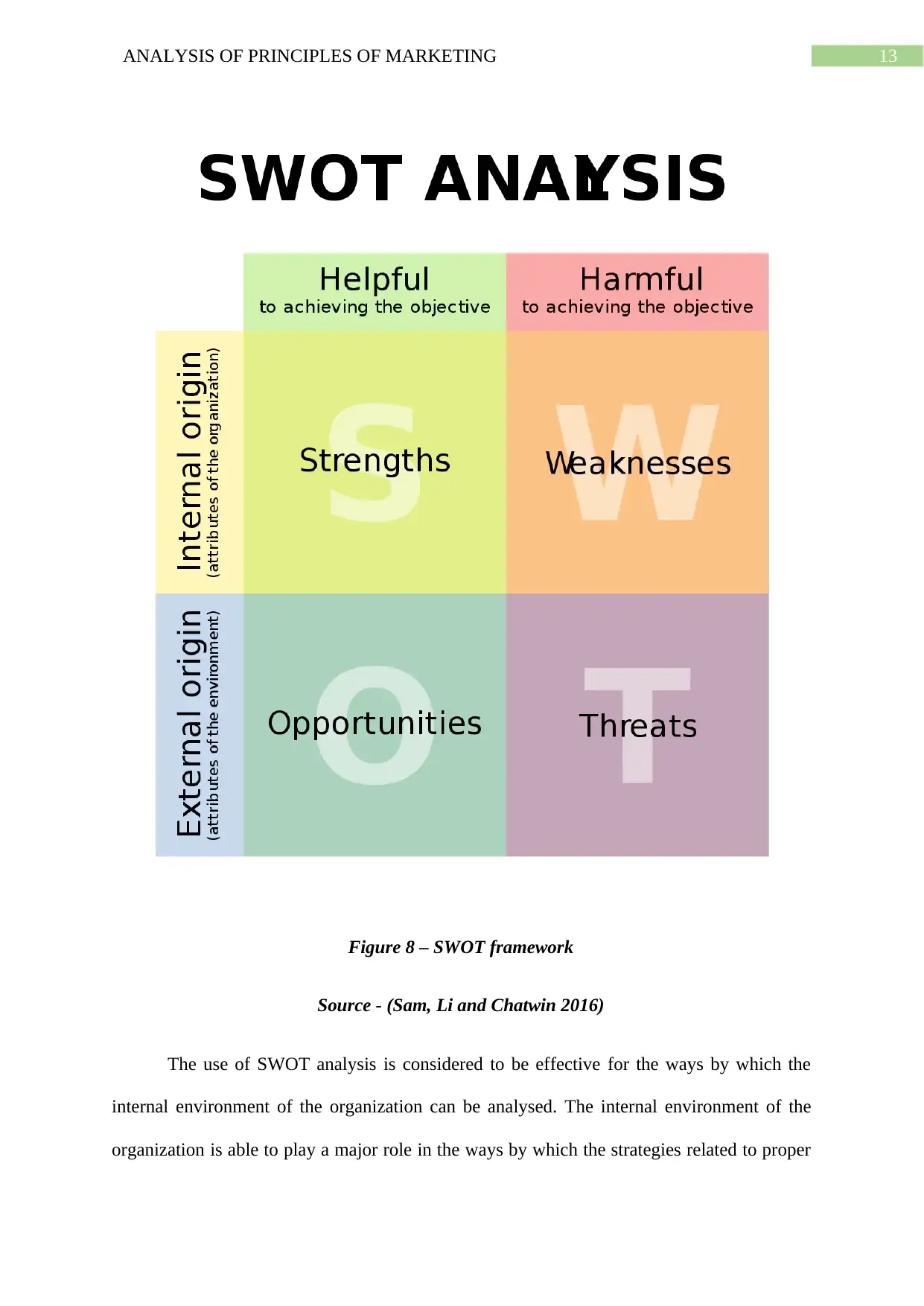
13ANALYSIS OF PRINCIPLES OF MARKETING
Figure 8 – SWOT framework
Source - (Sam, Li and Chatwin 2016)
The use of SWOT analysis is considered to be effective for the ways by which the
internal environment of the organization can be analysed. The internal environment of the
organization is able to play a major role in the ways by which the strategies related to proper
Figure 8 – SWOT framework
Source - (Sam, Li and Chatwin 2016)
The use of SWOT analysis is considered to be effective for the ways by which the
internal environment of the organization can be analysed. The internal environment of the
organization is able to play a major role in the ways by which the strategies related to proper
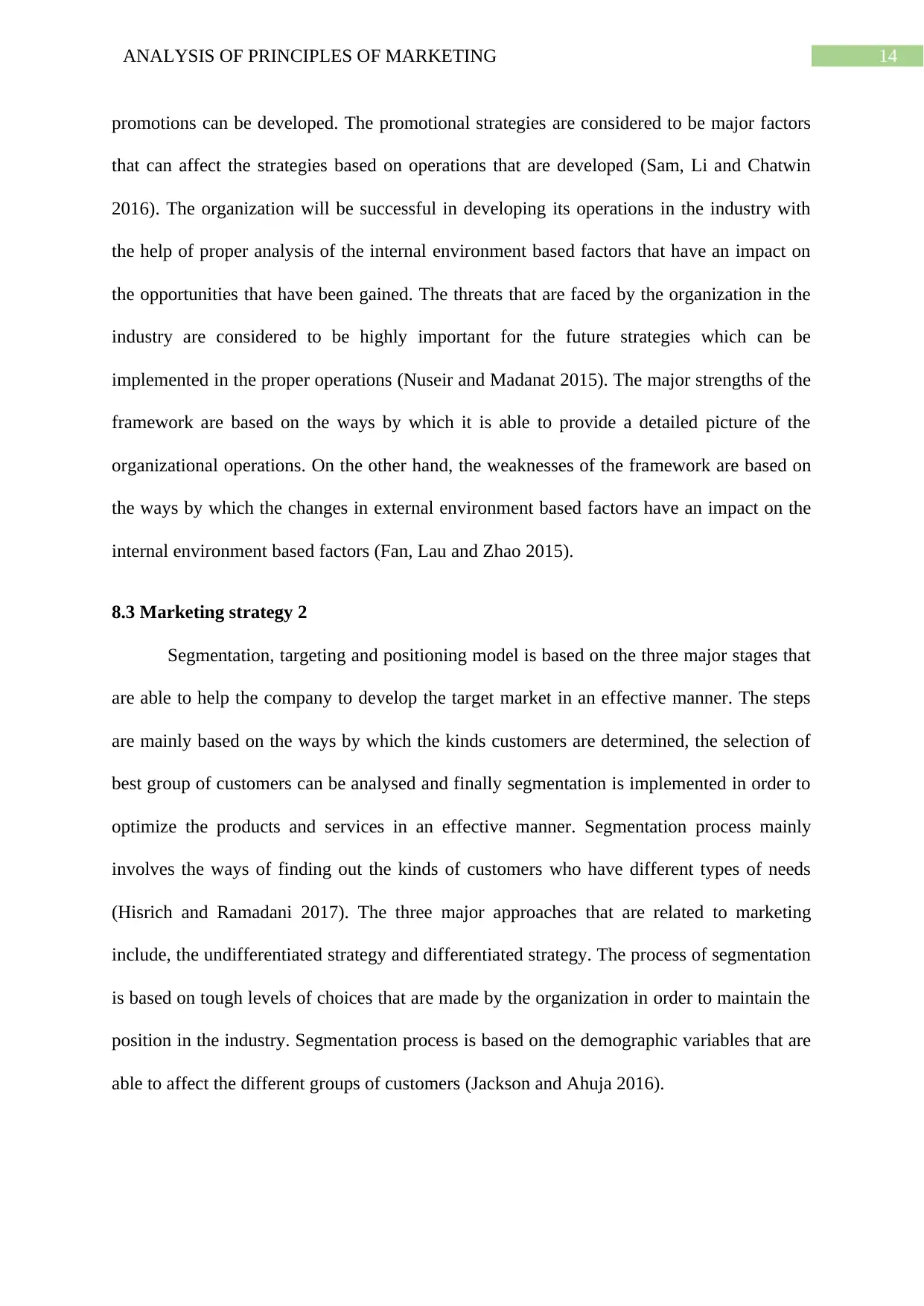
14ANALYSIS OF PRINCIPLES OF MARKETING
promotions can be developed. The promotional strategies are considered to be major factors
that can affect the strategies based on operations that are developed (Sam, Li and Chatwin
2016). The organization will be successful in developing its operations in the industry with
the help of proper analysis of the internal environment based factors that have an impact on
the opportunities that have been gained. The threats that are faced by the organization in the
industry are considered to be highly important for the future strategies which can be
implemented in the proper operations (Nuseir and Madanat 2015). The major strengths of the
framework are based on the ways by which it is able to provide a detailed picture of the
organizational operations. On the other hand, the weaknesses of the framework are based on
the ways by which the changes in external environment based factors have an impact on the
internal environment based factors (Fan, Lau and Zhao 2015).
8.3 Marketing strategy 2
Segmentation, targeting and positioning model is based on the three major stages that
are able to help the company to develop the target market in an effective manner. The steps
are mainly based on the ways by which the kinds customers are determined, the selection of
best group of customers can be analysed and finally segmentation is implemented in order to
optimize the products and services in an effective manner. Segmentation process mainly
involves the ways of finding out the kinds of customers who have different types of needs
(Hisrich and Ramadani 2017). The three major approaches that are related to marketing
include, the undifferentiated strategy and differentiated strategy. The process of segmentation
is based on tough levels of choices that are made by the organization in order to maintain the
position in the industry. Segmentation process is based on the demographic variables that are
able to affect the different groups of customers (Jackson and Ahuja 2016).
promotions can be developed. The promotional strategies are considered to be major factors
that can affect the strategies based on operations that are developed (Sam, Li and Chatwin
2016). The organization will be successful in developing its operations in the industry with
the help of proper analysis of the internal environment based factors that have an impact on
the opportunities that have been gained. The threats that are faced by the organization in the
industry are considered to be highly important for the future strategies which can be
implemented in the proper operations (Nuseir and Madanat 2015). The major strengths of the
framework are based on the ways by which it is able to provide a detailed picture of the
organizational operations. On the other hand, the weaknesses of the framework are based on
the ways by which the changes in external environment based factors have an impact on the
internal environment based factors (Fan, Lau and Zhao 2015).
8.3 Marketing strategy 2
Segmentation, targeting and positioning model is based on the three major stages that
are able to help the company to develop the target market in an effective manner. The steps
are mainly based on the ways by which the kinds customers are determined, the selection of
best group of customers can be analysed and finally segmentation is implemented in order to
optimize the products and services in an effective manner. Segmentation process mainly
involves the ways of finding out the kinds of customers who have different types of needs
(Hisrich and Ramadani 2017). The three major approaches that are related to marketing
include, the undifferentiated strategy and differentiated strategy. The process of segmentation
is based on tough levels of choices that are made by the organization in order to maintain the
position in the industry. Segmentation process is based on the demographic variables that are
able to affect the different groups of customers (Jackson and Ahuja 2016).
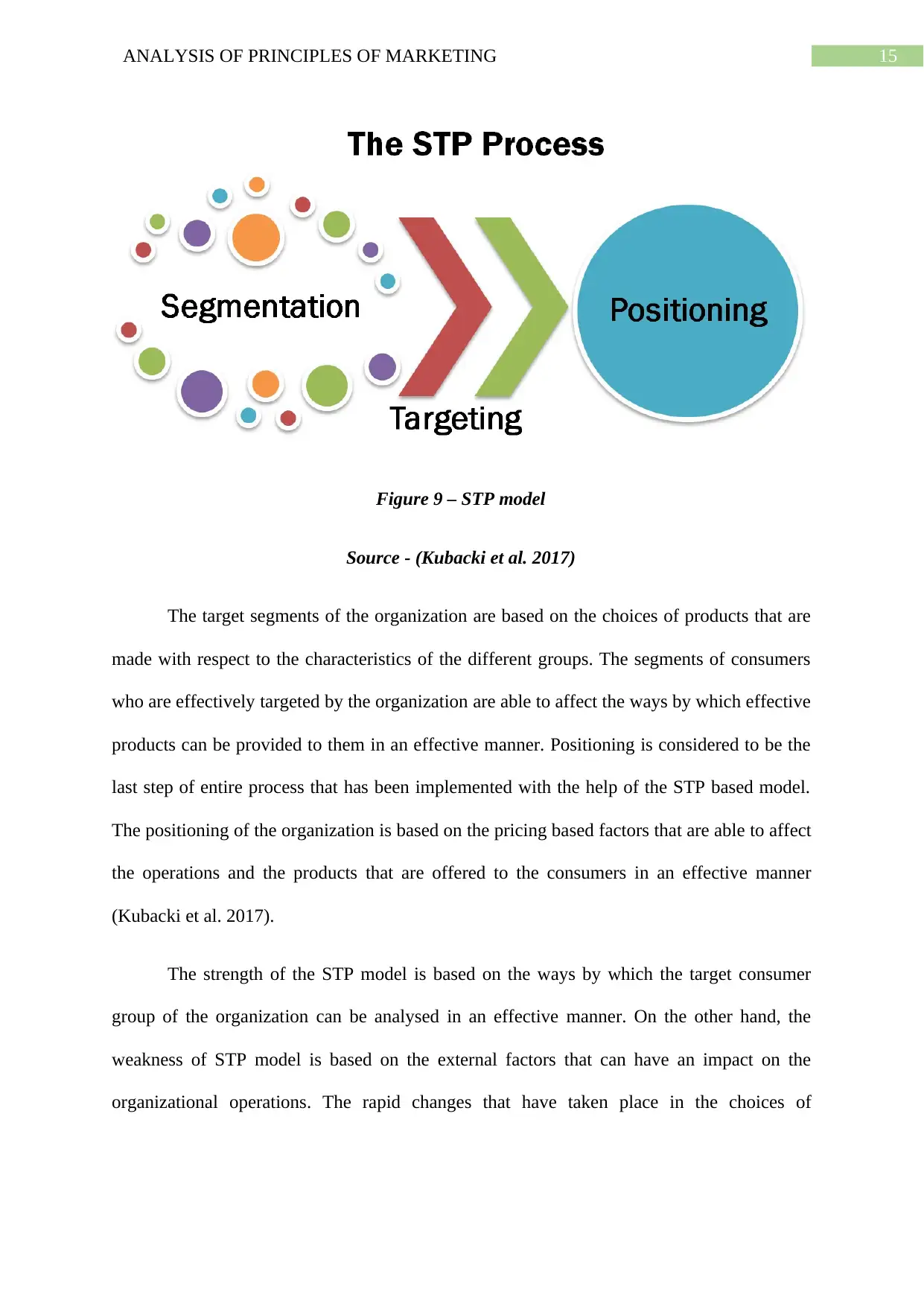
15ANALYSIS OF PRINCIPLES OF MARKETING
Figure 9 – STP model
Source - (Kubacki et al. 2017)
The target segments of the organization are based on the choices of products that are
made with respect to the characteristics of the different groups. The segments of consumers
who are effectively targeted by the organization are able to affect the ways by which effective
products can be provided to them in an effective manner. Positioning is considered to be the
last step of entire process that has been implemented with the help of the STP based model.
The positioning of the organization is based on the pricing based factors that are able to affect
the operations and the products that are offered to the consumers in an effective manner
(Kubacki et al. 2017).
The strength of the STP model is based on the ways by which the target consumer
group of the organization can be analysed in an effective manner. On the other hand, the
weakness of STP model is based on the external factors that can have an impact on the
organizational operations. The rapid changes that have taken place in the choices of
Figure 9 – STP model
Source - (Kubacki et al. 2017)
The target segments of the organization are based on the choices of products that are
made with respect to the characteristics of the different groups. The segments of consumers
who are effectively targeted by the organization are able to affect the ways by which effective
products can be provided to them in an effective manner. Positioning is considered to be the
last step of entire process that has been implemented with the help of the STP based model.
The positioning of the organization is based on the pricing based factors that are able to affect
the operations and the products that are offered to the consumers in an effective manner
(Kubacki et al. 2017).
The strength of the STP model is based on the ways by which the target consumer
group of the organization can be analysed in an effective manner. On the other hand, the
weakness of STP model is based on the external factors that can have an impact on the
organizational operations. The rapid changes that have taken place in the choices of
Secure Best Marks with AI Grader
Need help grading? Try our AI Grader for instant feedback on your assignments.
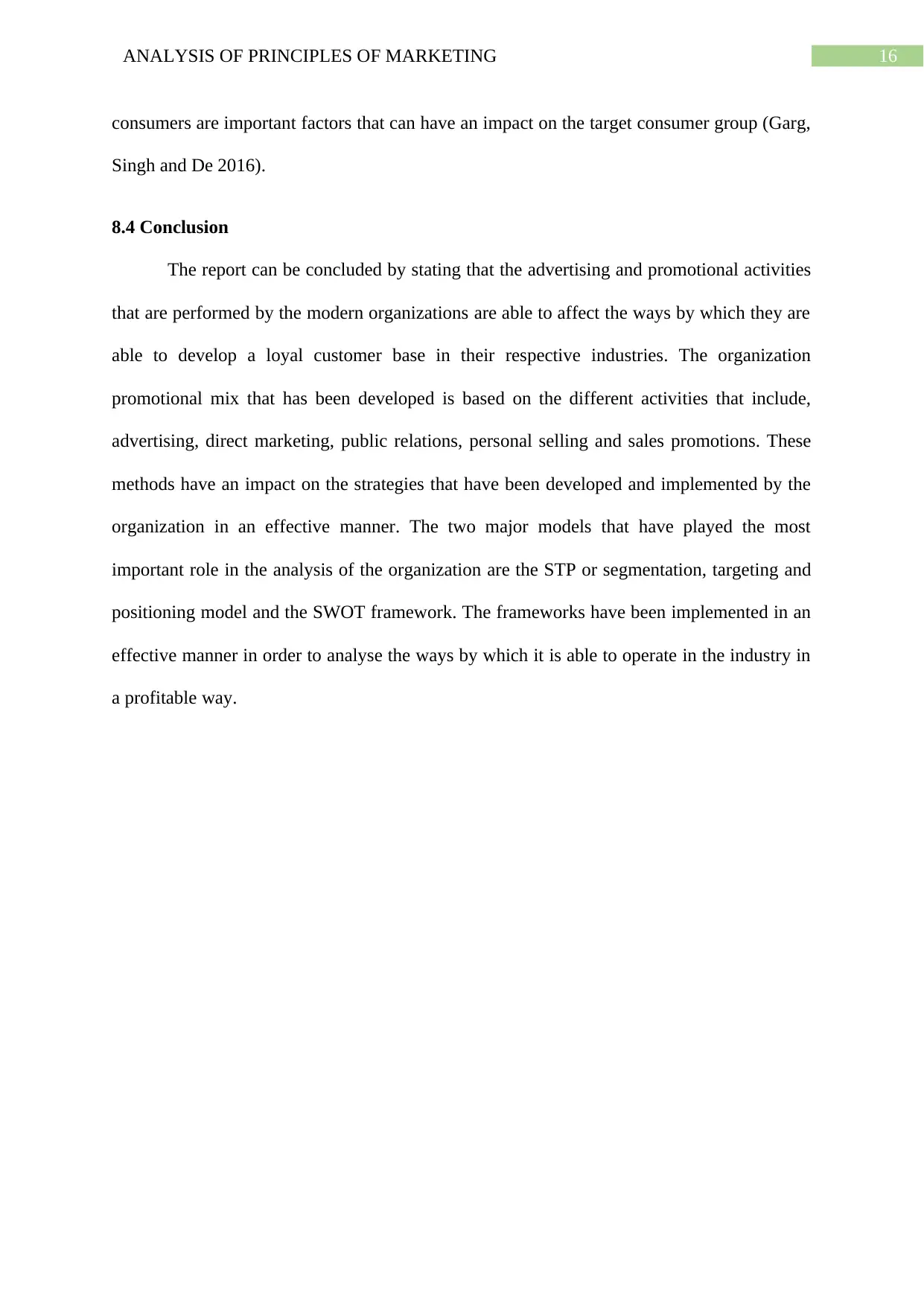
16ANALYSIS OF PRINCIPLES OF MARKETING
consumers are important factors that can have an impact on the target consumer group (Garg,
Singh and De 2016).
8.4 Conclusion
The report can be concluded by stating that the advertising and promotional activities
that are performed by the modern organizations are able to affect the ways by which they are
able to develop a loyal customer base in their respective industries. The organization
promotional mix that has been developed is based on the different activities that include,
advertising, direct marketing, public relations, personal selling and sales promotions. These
methods have an impact on the strategies that have been developed and implemented by the
organization in an effective manner. The two major models that have played the most
important role in the analysis of the organization are the STP or segmentation, targeting and
positioning model and the SWOT framework. The frameworks have been implemented in an
effective manner in order to analyse the ways by which it is able to operate in the industry in
a profitable way.
consumers are important factors that can have an impact on the target consumer group (Garg,
Singh and De 2016).
8.4 Conclusion
The report can be concluded by stating that the advertising and promotional activities
that are performed by the modern organizations are able to affect the ways by which they are
able to develop a loyal customer base in their respective industries. The organization
promotional mix that has been developed is based on the different activities that include,
advertising, direct marketing, public relations, personal selling and sales promotions. These
methods have an impact on the strategies that have been developed and implemented by the
organization in an effective manner. The two major models that have played the most
important role in the analysis of the organization are the STP or segmentation, targeting and
positioning model and the SWOT framework. The frameworks have been implemented in an
effective manner in order to analyse the ways by which it is able to operate in the industry in
a profitable way.
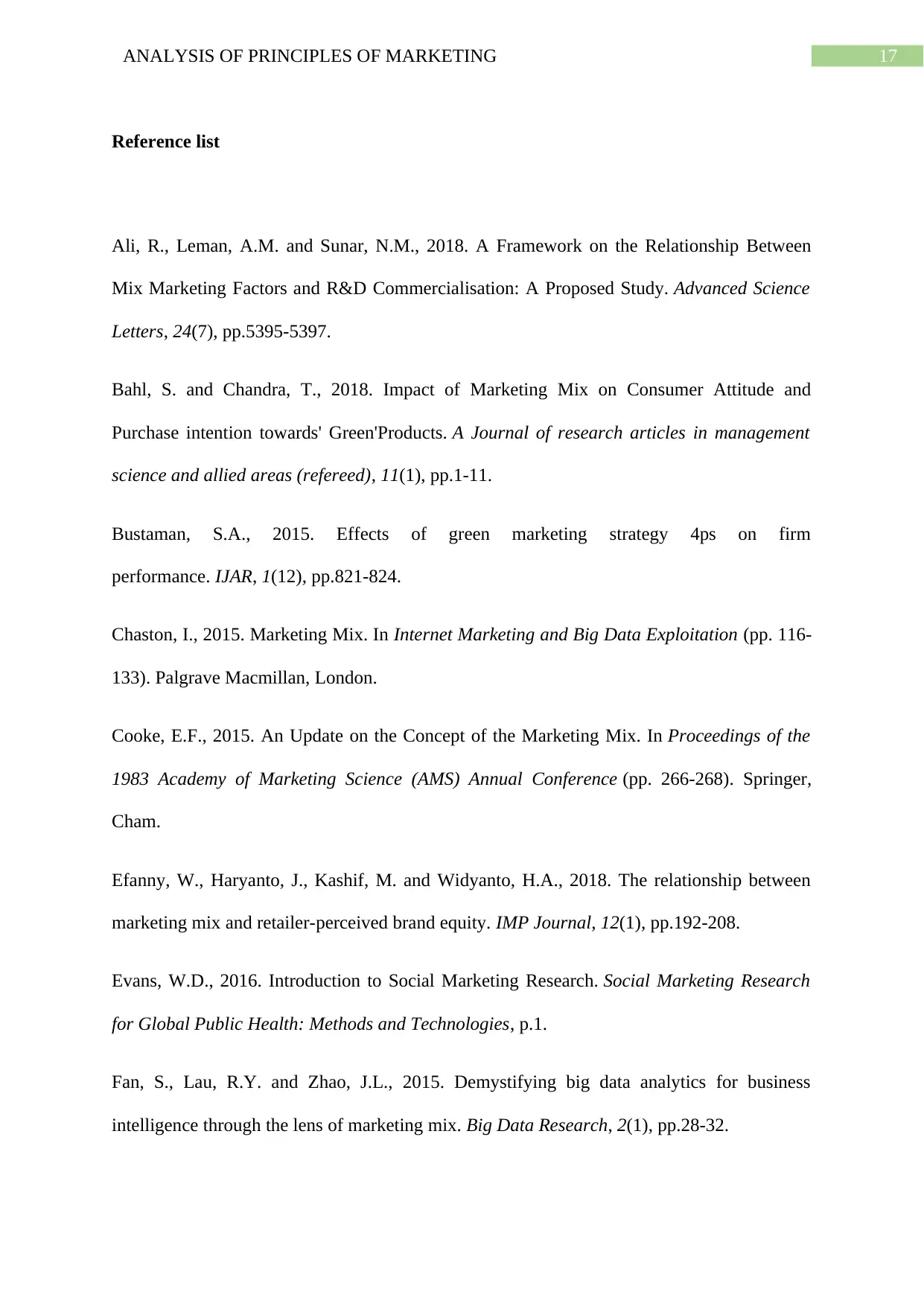
17ANALYSIS OF PRINCIPLES OF MARKETING
Reference list
Ali, R., Leman, A.M. and Sunar, N.M., 2018. A Framework on the Relationship Between
Mix Marketing Factors and R&D Commercialisation: A Proposed Study. Advanced Science
Letters, 24(7), pp.5395-5397.
Bahl, S. and Chandra, T., 2018. Impact of Marketing Mix on Consumer Attitude and
Purchase intention towards' Green'Products. A Journal of research articles in management
science and allied areas (refereed), 11(1), pp.1-11.
Bustaman, S.A., 2015. Effects of green marketing strategy 4ps on firm
performance. IJAR, 1(12), pp.821-824.
Chaston, I., 2015. Marketing Mix. In Internet Marketing and Big Data Exploitation (pp. 116-
133). Palgrave Macmillan, London.
Cooke, E.F., 2015. An Update on the Concept of the Marketing Mix. In Proceedings of the
1983 Academy of Marketing Science (AMS) Annual Conference (pp. 266-268). Springer,
Cham.
Efanny, W., Haryanto, J., Kashif, M. and Widyanto, H.A., 2018. The relationship between
marketing mix and retailer-perceived brand equity. IMP Journal, 12(1), pp.192-208.
Evans, W.D., 2016. Introduction to Social Marketing Research. Social Marketing Research
for Global Public Health: Methods and Technologies, p.1.
Fan, S., Lau, R.Y. and Zhao, J.L., 2015. Demystifying big data analytics for business
intelligence through the lens of marketing mix. Big Data Research, 2(1), pp.28-32.
Reference list
Ali, R., Leman, A.M. and Sunar, N.M., 2018. A Framework on the Relationship Between
Mix Marketing Factors and R&D Commercialisation: A Proposed Study. Advanced Science
Letters, 24(7), pp.5395-5397.
Bahl, S. and Chandra, T., 2018. Impact of Marketing Mix on Consumer Attitude and
Purchase intention towards' Green'Products. A Journal of research articles in management
science and allied areas (refereed), 11(1), pp.1-11.
Bustaman, S.A., 2015. Effects of green marketing strategy 4ps on firm
performance. IJAR, 1(12), pp.821-824.
Chaston, I., 2015. Marketing Mix. In Internet Marketing and Big Data Exploitation (pp. 116-
133). Palgrave Macmillan, London.
Cooke, E.F., 2015. An Update on the Concept of the Marketing Mix. In Proceedings of the
1983 Academy of Marketing Science (AMS) Annual Conference (pp. 266-268). Springer,
Cham.
Efanny, W., Haryanto, J., Kashif, M. and Widyanto, H.A., 2018. The relationship between
marketing mix and retailer-perceived brand equity. IMP Journal, 12(1), pp.192-208.
Evans, W.D., 2016. Introduction to Social Marketing Research. Social Marketing Research
for Global Public Health: Methods and Technologies, p.1.
Fan, S., Lau, R.Y. and Zhao, J.L., 2015. Demystifying big data analytics for business
intelligence through the lens of marketing mix. Big Data Research, 2(1), pp.28-32.
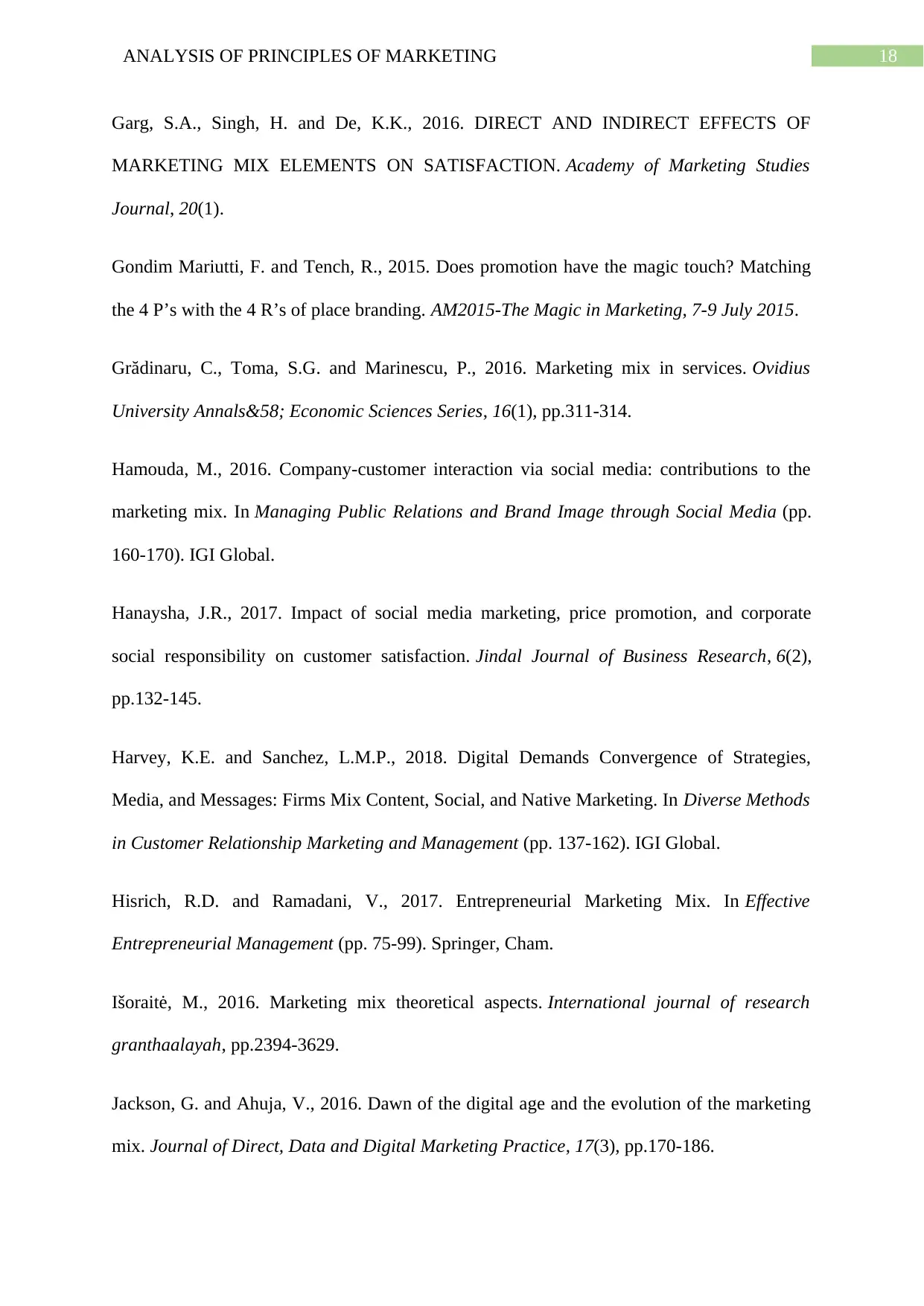
18ANALYSIS OF PRINCIPLES OF MARKETING
Garg, S.A., Singh, H. and De, K.K., 2016. DIRECT AND INDIRECT EFFECTS OF
MARKETING MIX ELEMENTS ON SATISFACTION. Academy of Marketing Studies
Journal, 20(1).
Gondim Mariutti, F. and Tench, R., 2015. Does promotion have the magic touch? Matching
the 4 P’s with the 4 R’s of place branding. AM2015-The Magic in Marketing, 7-9 July 2015.
Grădinaru, C., Toma, S.G. and Marinescu, P., 2016. Marketing mix in services. Ovidius
University Annals&58; Economic Sciences Series, 16(1), pp.311-314.
Hamouda, M., 2016. Company-customer interaction via social media: contributions to the
marketing mix. In Managing Public Relations and Brand Image through Social Media (pp.
160-170). IGI Global.
Hanaysha, J.R., 2017. Impact of social media marketing, price promotion, and corporate
social responsibility on customer satisfaction. Jindal Journal of Business Research, 6(2),
pp.132-145.
Harvey, K.E. and Sanchez, L.M.P., 2018. Digital Demands Convergence of Strategies,
Media, and Messages: Firms Mix Content, Social, and Native Marketing. In Diverse Methods
in Customer Relationship Marketing and Management (pp. 137-162). IGI Global.
Hisrich, R.D. and Ramadani, V., 2017. Entrepreneurial Marketing Mix. In Effective
Entrepreneurial Management (pp. 75-99). Springer, Cham.
Išoraitė, M., 2016. Marketing mix theoretical aspects. International journal of research
granthaalayah, pp.2394-3629.
Jackson, G. and Ahuja, V., 2016. Dawn of the digital age and the evolution of the marketing
mix. Journal of Direct, Data and Digital Marketing Practice, 17(3), pp.170-186.
Garg, S.A., Singh, H. and De, K.K., 2016. DIRECT AND INDIRECT EFFECTS OF
MARKETING MIX ELEMENTS ON SATISFACTION. Academy of Marketing Studies
Journal, 20(1).
Gondim Mariutti, F. and Tench, R., 2015. Does promotion have the magic touch? Matching
the 4 P’s with the 4 R’s of place branding. AM2015-The Magic in Marketing, 7-9 July 2015.
Grădinaru, C., Toma, S.G. and Marinescu, P., 2016. Marketing mix in services. Ovidius
University Annals&58; Economic Sciences Series, 16(1), pp.311-314.
Hamouda, M., 2016. Company-customer interaction via social media: contributions to the
marketing mix. In Managing Public Relations and Brand Image through Social Media (pp.
160-170). IGI Global.
Hanaysha, J.R., 2017. Impact of social media marketing, price promotion, and corporate
social responsibility on customer satisfaction. Jindal Journal of Business Research, 6(2),
pp.132-145.
Harvey, K.E. and Sanchez, L.M.P., 2018. Digital Demands Convergence of Strategies,
Media, and Messages: Firms Mix Content, Social, and Native Marketing. In Diverse Methods
in Customer Relationship Marketing and Management (pp. 137-162). IGI Global.
Hisrich, R.D. and Ramadani, V., 2017. Entrepreneurial Marketing Mix. In Effective
Entrepreneurial Management (pp. 75-99). Springer, Cham.
Išoraitė, M., 2016. Marketing mix theoretical aspects. International journal of research
granthaalayah, pp.2394-3629.
Jackson, G. and Ahuja, V., 2016. Dawn of the digital age and the evolution of the marketing
mix. Journal of Direct, Data and Digital Marketing Practice, 17(3), pp.170-186.
Paraphrase This Document
Need a fresh take? Get an instant paraphrase of this document with our AI Paraphraser
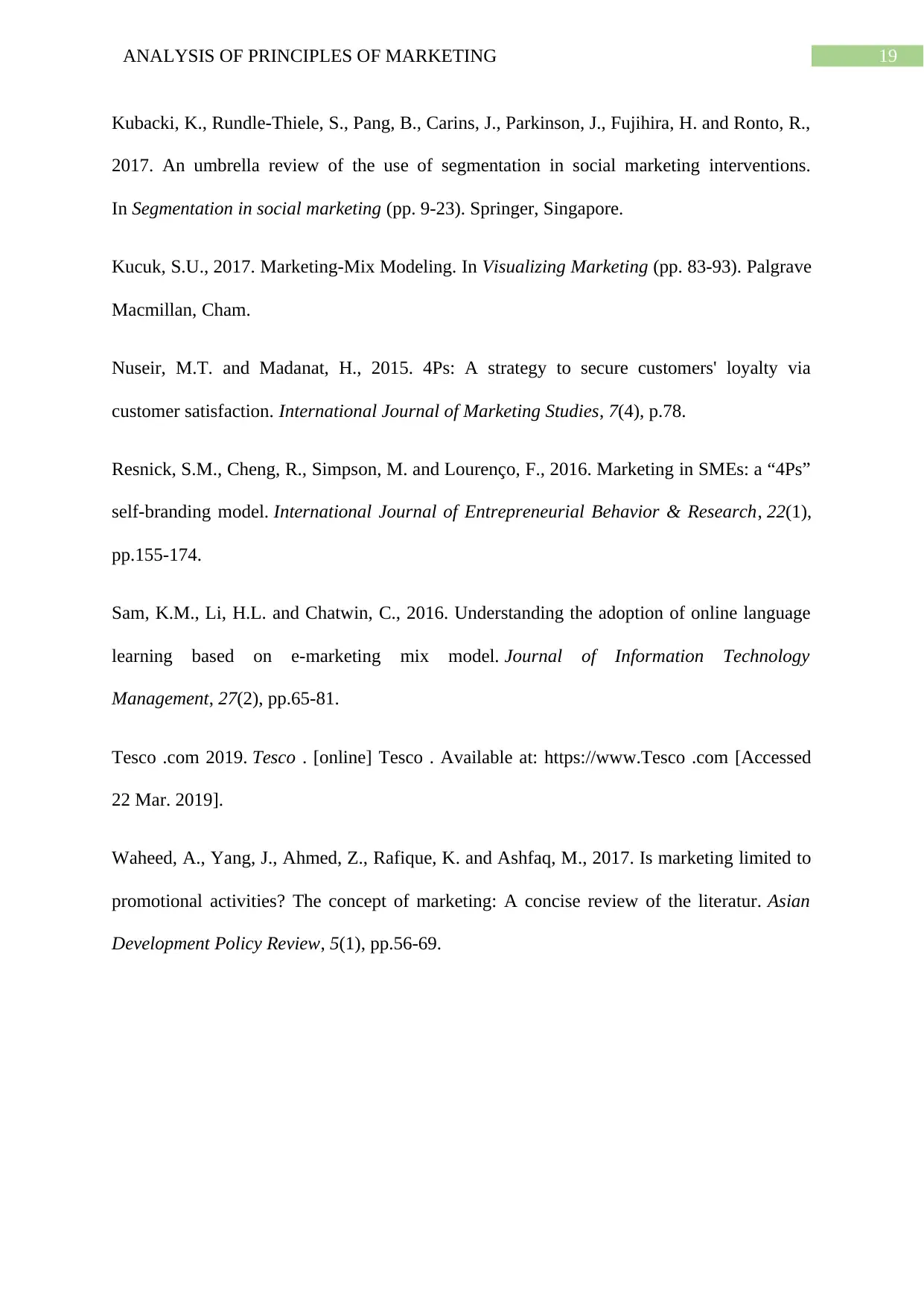
19ANALYSIS OF PRINCIPLES OF MARKETING
Kubacki, K., Rundle-Thiele, S., Pang, B., Carins, J., Parkinson, J., Fujihira, H. and Ronto, R.,
2017. An umbrella review of the use of segmentation in social marketing interventions.
In Segmentation in social marketing (pp. 9-23). Springer, Singapore.
Kucuk, S.U., 2017. Marketing-Mix Modeling. In Visualizing Marketing (pp. 83-93). Palgrave
Macmillan, Cham.
Nuseir, M.T. and Madanat, H., 2015. 4Ps: A strategy to secure customers' loyalty via
customer satisfaction. International Journal of Marketing Studies, 7(4), p.78.
Resnick, S.M., Cheng, R., Simpson, M. and Lourenço, F., 2016. Marketing in SMEs: a “4Ps”
self-branding model. International Journal of Entrepreneurial Behavior & Research, 22(1),
pp.155-174.
Sam, K.M., Li, H.L. and Chatwin, C., 2016. Understanding the adoption of online language
learning based on e-marketing mix model. Journal of Information Technology
Management, 27(2), pp.65-81.
Tesco .com 2019. Tesco . [online] Tesco . Available at: https://www.Tesco .com [Accessed
22 Mar. 2019].
Waheed, A., Yang, J., Ahmed, Z., Rafique, K. and Ashfaq, M., 2017. Is marketing limited to
promotional activities? The concept of marketing: A concise review of the literatur. Asian
Development Policy Review, 5(1), pp.56-69.
Kubacki, K., Rundle-Thiele, S., Pang, B., Carins, J., Parkinson, J., Fujihira, H. and Ronto, R.,
2017. An umbrella review of the use of segmentation in social marketing interventions.
In Segmentation in social marketing (pp. 9-23). Springer, Singapore.
Kucuk, S.U., 2017. Marketing-Mix Modeling. In Visualizing Marketing (pp. 83-93). Palgrave
Macmillan, Cham.
Nuseir, M.T. and Madanat, H., 2015. 4Ps: A strategy to secure customers' loyalty via
customer satisfaction. International Journal of Marketing Studies, 7(4), p.78.
Resnick, S.M., Cheng, R., Simpson, M. and Lourenço, F., 2016. Marketing in SMEs: a “4Ps”
self-branding model. International Journal of Entrepreneurial Behavior & Research, 22(1),
pp.155-174.
Sam, K.M., Li, H.L. and Chatwin, C., 2016. Understanding the adoption of online language
learning based on e-marketing mix model. Journal of Information Technology
Management, 27(2), pp.65-81.
Tesco .com 2019. Tesco . [online] Tesco . Available at: https://www.Tesco .com [Accessed
22 Mar. 2019].
Waheed, A., Yang, J., Ahmed, Z., Rafique, K. and Ashfaq, M., 2017. Is marketing limited to
promotional activities? The concept of marketing: A concise review of the literatur. Asian
Development Policy Review, 5(1), pp.56-69.
1 out of 20
Related Documents
Your All-in-One AI-Powered Toolkit for Academic Success.
+13062052269
info@desklib.com
Available 24*7 on WhatsApp / Email
![[object Object]](/_next/static/media/star-bottom.7253800d.svg)
Unlock your academic potential
© 2024 | Zucol Services PVT LTD | All rights reserved.





